#its a collection of digital + film I’ve taken around the world
Explore tagged Tumblr posts
Text

living room gallery wall is coming along!
#still got a few more pieces to hang up#its a collection of digital + film I’ve taken around the world#pieces my dad handed down to me#my favorite paintings and a painting of me done by one of my best friends!#and some cute lil shelves for vinyls#gonna get a piece or two in the South of France next month to complete the wall#I’m obsessed w decorating but I’m also a perfectionist so it takes like an entire fiscal quarter for me to fully decorate a new space#me#gay#musings#queer#gayguy#gayhot#gay jock#new apartment#my apartment
10 notes
·
View notes
Text

Twelve Dreams of Dr Sardonicus by Spirit
My parents were desperate for me to like classical music, but I just couldn’t buy into the length of the pieces. Then they played me Adagio for Strings by Samuel Barber and it was so beautiful, I cried. My school music teacher, Mr Vassal, asked for our favourite composers; I said Samuel Barber and he laughed at me. But eventually everyone caught up.
There was a Beatles versus Stones vibe at school. I was on the Beatles side. The first single I bought was Wild Thing by the Troggs and the first album was Bookends by Simon and Garfunkel. I loved Father and Son by Cat Stevens, because it made me think of me and my dad. My tastes weren’t shocking; they just needed to open up. Then, when I was 17, I went to hospital to have my tonsils out and my brother bought me some records and this mobile turntable in a suitcase.
Twelve Dreams of Dr Sardonicus by Spirit had the most amazing way of manipulating stereo. I was just blown away. I have to thank my brother; he turned me on to Joni Mitchell, Andy Pratt and Little Feat and opened up my boundaries.
Little Brother, Little Sister
My mother, Helen Shingler, was famous during my teens for playing Madame Maigret in a BBC series based on the Georges Simenon stories. My father, Seafield Head, was a producer and director at Verity Films, the documentary film company. Every year, a family friend’s mum would hire this huge barn and put on a play. I had a bit part in The Jackdaw of Rheims. The next year, I got to be the Emperor in The Emperor’s New Clothes. As I walked through the audience, all heads turned towards me and I remember thinking: “This is what I want to do for a living.”
I applied to the National Youth Theatre and the Central School of Speech and Drama, but I didn’t get in, so my father hired me as a runner and assistant editor. Working in the cutting rooms was fascinating. Then I enrolled at The Young Stagers at the Thorndike theatre in Leatherhead, run by this lovely woman called Joan MacAlpine. She directed me in an extraordinary piece called Little Brother, Little Sister, which got me into the London Academy of Music and Dramatic Art. My teacher said: “If anybody can make me cry, I’ll take them to the theatre.” I did my piece again and made her cry.
The Rocky Horror Show
I remember being taken to The Rocky Horror Show on Kings Road when I was at drama school in my late teens. Tim Curry was playing Dr Frank-N-Furter – the role that he repeated in the film. Watching The Rocky Horror Show ignited something in my core. I knew I had acting in my blood because of my mother. Now I couldn’t wait to finish drama school and try to make it in the real world.
I finally got to play Dr Frank-N-Furter when The Rocky Horror Show came to the Piccadilly theatre in 1990. The exciting thing about acting is that you shouldn’t know what’s coming out of the actor’s mouth next – and I didn’t hold back. I just let whatever was going on inside of me come out in the character. That was life-changing for me as an actor. It made me realise that there’s nowhere that you can’t go.
Friends would come to see me perform and later say that they hardly recognised me, I was so out of character. As an actor, that’s a huge compliment.
Judi Dench
Judi Dench and Maurice Denham in 1966’s Talking to a Stranger. Photograph: Everett Collection/Alamy
One of Judi Dench’s early roles was this show on BBC Two called Talking to a Stranger, with Michael Bryant, Maurice Denham and Margery Mason. It’s about this family who are at odds with each other. Each of the four parts focuses on one family member’s view of what is going on around them. I thought it was beautiful, amazing and absolutely genius and I just fell in love with Judi. I thought that she was the most amazing actress – and still do. Judi taught me that acting can be at its best when it is very subtly underplayed. The core of believing an actor is buying into the fact that they’re not acting.
I got to play the rather unpleasant suitor of one of her on-screen daughters in Love in a Cold Climate on the BBC in the early 00s. I’m sure I must have said to Judi: ‘I think you’re so wonderful.’ Actors need appreciation and recognition. I suppose for me that will always be for Buffy, because Buffy was so different and so pivotal for its time. The episode called The Body, where Buffy’s mum dies, is the most extraordinary piece of writing and misdirection. I’m very grateful to have done so many evocative things that so many people have latched on to.
Paul Newman
Robert Redford and Paul Newman in 1969’s Butch Cassidy and the Sundance Kid. Photograph: Photos 12/Alamy
I love Butch Cassidy and the Sundance Kid. Each act is so brilliantly put together; it’s a stunning piece of writing. Both Robert Redford and Paul Newman are phenomenal, but Newman especially I’ve always loved, because he’s so believable that he instantly transports you into the story. I also loved Henry Fonda in Once Upon a Time in the West, in which he plays the baddie, which is unusual.
I often get cast as baddies. I don’t know why. I play Rupert Mannion on [the Apple TV+ sitcom] Ted Lasso. He’s a particularly unpleasant character and a complete narcissist, but you know where he’s coming from. To make somebody believable, you have to see their point of view. You don’t need to like them, but you have to be on board with what’s driving them.
I’m also in an episode of the new series of Back with David Mitchell and Robert Webb. I get to play a totally self-absorbed character called Charismatic Mike, who was great fun to play. It’s always been my theory that actors are hugely insecure, which is why we love dressing up and being someone else, because we don’t have to be in our own heads and bodies. Then we can express things that we may feel deep down and blame it on the character.
Lord of the Flies
At drama school, I really liked the people on the stage-managing course who were studying things like costume, lighting and prop-making. People used to say: you have to behave like a star to be thought of as a star. So, traditionally, a lot of actors take stage managers for granted.
I get very cross with actors who just throw their clothes on the floor. I said to one actor recently: “Costume are here before you, setting up your clothes, and they’re here after you’ve gone. Pick up your clothes, put them on a hanger in your cupboard. It’s not a big deal.” Teamwork is important.
At school, one of the books that blew me away was Lord of the Flies. It’s also about teamwork and not necessarily someone standing in front becoming the leader. In your teens, the world is yours to do what you want with. As you grow up, you realise you’re just part of something much bigger. Now more than ever, life should be about teamwork and for the cause of the greater good.
School’s Out Forever is available on digital from 15 February and DVD and Blu-ray from 12 April
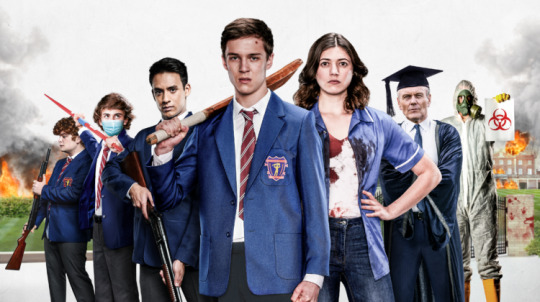
36 notes
·
View notes
Text
Thoughts : WandaVision [Disney+, Episodes 4-6] (2021)

After a heavily stylized trio of opening episodes, WandaVision has officially put the pedal to the metal with its next trio of episodes. The connections to the larger MCU have been firmly identified and established, which has generated a mountain of new questions, speculations and assumptions about where WandaVision, and in turn, the MCU as a whole are headed in the next few phases.
Editor’s note : This show is jumping in quality from episode to episode, and based on the response to the last blog entry on WandaVision, I am considering giving the final 3 episodes their own entries. If the likes on this blog entry surpass those of the previous WandaVision entry, I will do dedicated breakdowns of the final 3 episodes on the date that they are released.
THE STORY THUS FAR
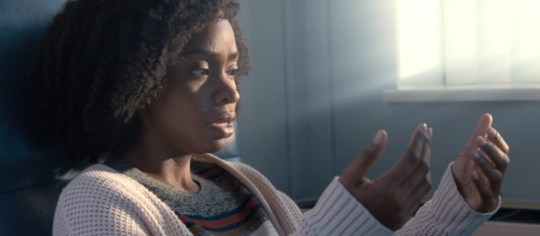
Episode 04 : We Interrupt This Program In the wake of The Blip, Monica Rambeau (Teyonah Parris) is returned to the hospital where she once sat by the side of her mother’s side. Upon returning to reality, Monica learns that Maria Rambeau has passed away due to cancer while she was gone, which devastates her to no end. Monica returns to S.W.O.R.D. in hopes of finding peace, but she is immediately thrust into the mysteries surround the town of Westview, New Jersey. CIA Agent Jimmy Woo (Randall Park) meets Monica outside of Westview, where he clues her in on his missing witness that was once in the town, as well as the anomaly of amnesia that has taken over those in the surrounding communities. Monica and Jimmy approach the city only to discover it is covered by a mysterious invisible barrier, and while inspecting the barrier, Monica is pulled in. S.H.I.E.L.D. calls in the Army, the FBI and a number of specialists in various fields, including astrophysicist Dr. Darcy Lewis (Kat Dennings), who stumbles upon a mysterious signal that allows those outside the barrier to view the events within in a sitcom format.
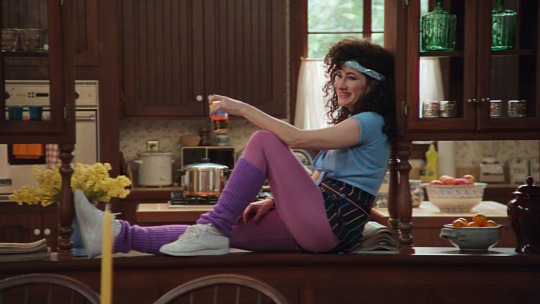
Episode 05 : On a Very Special Episode... Wanda and Vision are doing their best to adjust to raising Tommy (Baylen Bielitz) and Billy (Gavin Borders), but find themselves overwhelmed until an overly enthusiastic Agnes steps in to help. While Vision questions Wanda on the recent strangeness, Tommy (Jett Klyne) and Billy (Julian Hilliard) suddenly jump to the age of ten, further confounding Vision. Outside of The Hex (a nickname for the anomaly surrounding Westview coined by Darcy), S.H.I.E.L.D. continues to gather intel and ramp up efforts to collect information in the wake of Monica Rambeau’s return, but after an attempt to communicate to Wanda directly goes awry, Wanda presents herself directly to S.H.I.E.L.D. with a warning to stay away. Vision has an encounter with Norm (Asif Ali) that causes him to reach his breaking point, and while he is confronting Wanda later that night, a knock on the door reveals that Pietro (Evan Peters) has somehow returned... but something is different about him...

Episode 06 : All-New Halloween Spooktacular! It’s Halloween in Westview, and the Maximoff family is preparing for a night of fun and adventure. Tommy is excited for all of the candy he will be collecting, but Billy finds himself concerned with a number of issues, chiefly the surprise emergence of Pietro onto the scene and the troubled waters flowing between Wanda and Vision. Wanda attempts to gather the family for their night out, but Vision states that he has obligations with the Neighbor Watch, which disappoints Wanda. Pietro offers to step in, and his mischievous influence leads to Tommy and Billy’s discovery of their powers. Outside of The Hex, tensions are running deeper between Agent Rambeau and Agent Hayward, and as a result, Hayward expels Rambeau, Jimmy and Darcy from the camp. The trio manages to sneak back in, and while Rambeau and Jimmy head to meet a colleague of Rambeau’s who can assist them in entering The Hex, Darcy breaks into Hayward’s digital files, uncovering a goldmine of shadiness. Vision, using his Neighborhood Watch story as cover, attempts to investigate the outskirts of Westview, but after breaking through the outer wall of The Hex he finds himself being literally torn apart as he is pulled back in, all in front of the eyes of Hayward and his team. Billy picks up on what is happening, and in a fit of desperation, Wanda makes a move to save Vision that drastically alters the entire scenario surrounding The Hex.
ADDITIONAL RESOURCES
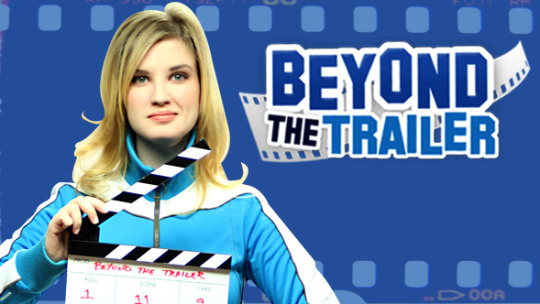
Beyond The Trailer YouTube Channel

New Rockstars YouTube Channel
I was unfamiliar with Beyond The Trailer prior to Episode 03 of WandaVision, but the discovery of the channel has provided me with sharp insight, as well as a bit of humor, and Grace Randolph is the only creator to my knowledge that is providing live reactions on episode premier dates.. New Rockstars and Erik Voss continue to mostly knock their analysis of the show out the box. Oddly enough, however, I have found myself pulling back from the YouTube camps of speculation as the series progresses. This is not a shot at any of the YouTubers that are dedicating their time and attention to the show, but rather a testament to the skill with which WandaVision was crafted, and the compelling mystique it has generated on its own.
THOUGHTS ON THE SHOW In all honesty, I have no idea how this overarching story of Wanda, Vision, the town of Westview, Monica Rambeau and S.W.O.R.D. are going to resolve themselves, and I couldn’t love that fact any more than I already do. The amount of detail infused into this show is insane : the way that the aspect ratio continues to shift depending on the “reality” we are viewing is a stroke of simple genius, the use of CMBR waves creating a television signal is a very subtle subtextual reminder of what it was like to take in entertainment prior to the advent of streaming, and the amount of Easter Eggs being dropped would put the Easter Bunny to shame. Just when we think we’ve got things figured out enough to hazard a guess, we are thrown monumental curveballs, and the whole while characters like Darcy, Jimmy Woo and Pietro are asking the same questions we are as viewers.
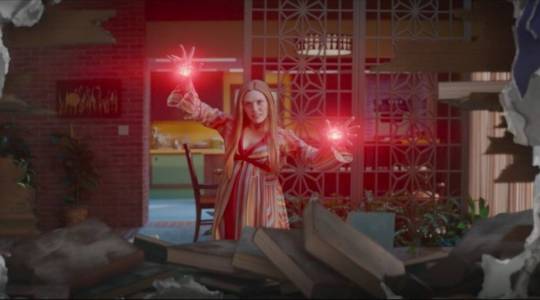
Wanda Maximoff had been using a very restrained, comical version of her powers up until this group of episodes, but now that her Chaos Magic has revealed itself, many are speculating that she may actually be the antagonist of the series, rather than the protagonist. It is clear that Wanda is controlling the majority of the Westview anomaly with her powers, but certain occurrences such as the birth of Tommy and Billy, their sudden aging or the appearance of the X-Men Quicksilver denotes that someone else is pulling strings that impact Wanda’s reality as well. It is also crystal clear that her anger and emotions are being held at bay by the thinnest of barriers, and with each step closer to her losing control, the real world ramifications get murkier and more dangerous.
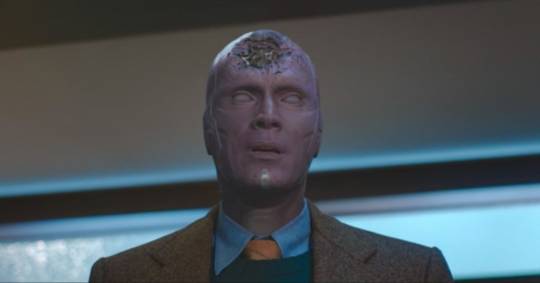
What on Earth is going on with Vision? We are given a brief glimpse of the actual “reality” behind Wanda’s created “reality”, and the most jaw-dropping revelation up to that time is the seemingly dead Vision interacting with Wanda in her created world. He is no longer in possession of the Mind Stone, and the infamous damage to his head (courtesy of Thanos) is still very much present. S.W.O.R.D. acting Director Tyler Hayward decided to reveal that S.W.O.R.D. was storing Vision’s corpse at the time that Wanda supposedly broke in and stole it, but even the validity of that is questionable considering how unlikeable Hayward chooses to be. I am also curious if the reason that everyone acts so cagey around Vision is because they see him as a corpse. Vision also seems to have holes in his overall awareness, including no knowledge of the Avengers, which makes you wonder who he truly is on top of what is going on with him.

Monica Rambeau seems to be holding back from exerting control over the situation at hand, especially in light of the fact that she’s the only person who has been on both sides of The Hex and has flatly declared that Wanda is the one in control. There is also an intentional glossing over of key things revolving around Monica that continue to stand out, chiefly among them being her lab readings that appear to have been whited out by a bright light, and the caginess exhibited whenever any references to Captain Marvel are made. She is also clearly a thorn in the side of S.W.O.R.D., and in spite of her connection to S.W.O.R.D. originator Maria Rambeau, it is clear that her presence is not welcome in the camp investigating The Hex.
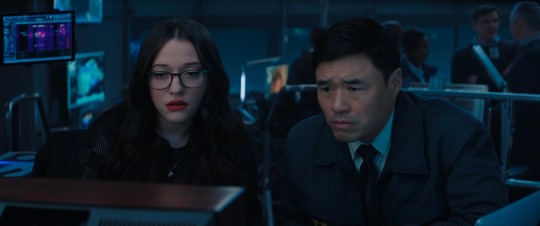
Dr. Darcy Lewis and Jimmy Woo are quickly becoming not only the fan favorites of the show, but the pairing we never knew that we needed. Darcy’s massive intellect, wealth of knowledge and razor-sharp sarcastic wit pair brilliantly with Woo’s empathic, perceptive abilities and kind-hearted, wholesome nature. With the mystery falling squarely into their laps, they have become the perfect guides through the madness for curious viewers, as many of their questions and concerns mirror those of the audience.

Pietro Maximoff may be the most intriguing appearance of any character in the MCU due to the possible implications that lie with his emergence. Is he actually Quicksilver? The alarms sounded during his appearance, so did he bring himself into The Hex, or was he allowed in by someone? If he is not the Pietro that we are familiar with, and he is playing games in regards to whether or not he is the real deal, then why does Wanda briefly see him just as dead as she sees Vision? Many YouTubers are speculating that the progression of decades used by the sitcom format is intentionally mirroring the decade jumps in the latest series of X-Men films, which is possibly causing some sort of fold in space-time that is combining alternate realities... whatever the explanation is for the emergence of the Evan Peters version of Quicksilver, I’ve never seen anything like this in media, and am wholly invested in seeing where this stroke of genius leads us.
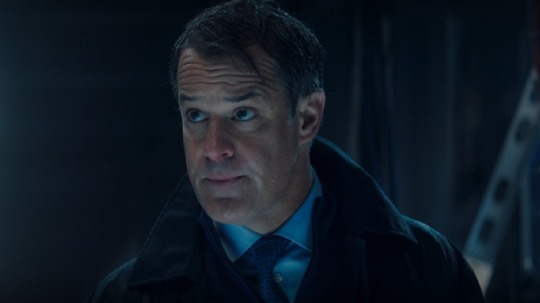
What exactly are Tyler Hayward‘s intentions with Vision, The Hex and Wanda? Why is he being so cagey with information and so ruthless with his control? What is his deal in regards to the clear-cut resentment he has for Monica Rambeau and her connections to those with powers, seemingly specifically Carol Danvers? Is he the true villainous antagonist, or is he just a pawn in a much bigger scheme?
THE QUESTIONS
- If Evan Peters is now Pietro Maximoff outside of the Fox X-Men franchise, is this the indicator that mutants now exist in the MCU? Or is this simply a meta-glitch to setup the rumors of similar occurrences that will happen in the upcoming Spider-man film?
- Why is Dottie still not on the board of identified individuals trapped in The Hex? Even Agnes is on the board, though she does not have a real-life identifier as of yet, which makes her mysterious as well.
- Who are the kids in the commercials, and what is their tie to the mysterious pair that appear in every commercial?
- Is all the talk of S.W.O.R.D.’s astronaut program and specialized aerospace engineers a way to set up the eventual introduction of Reed Richards (and eventually the Fantastic Four) into the MCU? Is this who Monica and Jimmy Woo are heading to meet in Episode 06?
- Is all of the hexagon imagery a way to establish a motif of evolving DNA? Does Vision mentioning the Charles Darwin book Descent of Man push this motif into the realms of mutation by way of genetic evolution?
- As Darcy mentions in Episode 06, Monica Rambeau’s two journeys through The Hex have fundamentally changed her down to the molecular level... are we seeing the emergence of Photon, and on a bigger scale, the mode in which Mutants will be created?
- Why is Marvel so good at cliffhanger endings? The last two episodes, in particular, have made waiting a week for the continuation of the story one of the most difficult things I have ever done. I’m hard-pressed to think of a show since The Sopranos that has kept me this anxious from week to week in anticipation of what will happen next.
#ChiefDoomsay#DOOMonFILM#Disney+#WandaVision#ElizabethOlsen#PaulBettany#KathrynHahn#TeyonahParis#KatDennings#RandallPark#JolenePurdy#AsifAli#DavidLengel#AmosGlick#EmmaCauflfieldFord#DavidPayton#RandyOglesby#RoseBlanco#IthamarEnriquez#VictoriaBlade#BaylenBieletz#GavinBorders#JettKlyne#JulianHilliard#EvanPeters#WeInterruptThisProgram#OnAVerySpecialEpisode
11 notes
·
View notes
Photo

Today is my last day at Frederator.
It’s a good day. If there’s a cheesier sentiment than “today is the first day of the rest of your life” I’m not sure what it would be. But, I’m a cheesy guy, and it’s how I feel.
Starting today, I’ve decided to leave Frederator and go back to my roots as an active, excited, indie cartoon producer who’s constantly searching –and finding!– unique talents with original voices. It’s what makes my days joyful and fulfilling. Yes, I know, that’s cheesy.
It’s an amazing, and unique, time for animation of all kinds. The Covid19 era has put a lot of live action on hold, and streaming has made more styles and genres of animation mainstreamed than ever in history. I’ve called “animation’s new golden age” at least twice before during my time, so I guess we’re entering a platinum age! I’m even more thrilled to be in animation now than I have ever been.
I’m happy to have brought Frederator into the WOW! family where I know it will continue to grow and thrive. I’m thrilled that I’ll be continuing to collaborate with the Frederator/Wow team on Castlevania and Bee and PuppyCat: Lazy in Space and a few new ones; we share the same passion that goes into this great field of animation entertainment. There’s an “official” press release at the bottom of this post that lays everything out.
Something personal to note. Building a venture like Frederator has it’s ups and downs. My great colleagues have ridden through it with great cheer and smarts. But, the most important supporters through it all are my wife and two sons. I’ve pushed them to the limits a number of times, but when I look around, they’re always there, supportive, encouraging, and always with smiles.
And, what’s heartened me everyday are the hundreds –maybe thousands?– of collaborators I’ve been honored to work with at the various Frederator endeavors over the years. I think I expressed it best a couple of years ago with this introduction of our 2018 retrospective book “Frederator Loves You.”
.....
Let me rant for a minute. I think the last twenty years has proved that there’s no other company like Frederator. Really, we’re special. Arrogant? Sure.
Of course, being remarkable is all about you.
"Frederator loves you" has been more than just a slogan around here. It's been a battle cry that expresses exactly why I started the company.
"You." First and foremost it's our audiences, whether they're the kids that watched our stuff on Nickelodeon and Cartoon Network, or the still-kids who grew up and watch us on Cartoon Hangover, Get in the Robot or Netflix.
"You." All the folks that work in and around Frederator across the globe, making cartoons and videos and channels, figuring out the best way to show them off to people.
And "you." The world class creators –mostly first timers– we've been lucky enough to have in our corner.
I think it's fair to say that without "you" there wouldn't be an "us." From my perspective we're all one big bunch, loving the same things, everyone playing their own roles. I don't think anyone at Frederator would have it any other way.
Twenty years [sic] seems like both a long time and yet, just the beginning. I can't imagine it ending, it’s just too much fun making the world smile.
Frederator loves you all, Fred Seibert
.....
Press Release

WOW! UNLIMITED MEDIA ANNOUNCES CORPORATE LEADERSHIP REORGANIZATION
CEO Michael Hirsh To Take on Leadership of Frederator
Fred Seibert, Frederator Founder and CEO, Returns to Independent Production
TORONTO and VANCOUVER, British Columbia, Aug. 27, 2020 (GLOBE NEWSWIRE) -- WOW! Unlimited Media, Inc. (“WOW!” or the “Company”) (TSX-V: WOW / OTCQX: WOWMF), a leading animation-focused entertainment company that includes Frederator Networks Inc. (“Frederator”) and Mainframe Studios, today announces a corporate leadership reorganization.
Fred Seibert has resigned from his position as a Director and the Chief Creative officer of WOW!, as well as CEO of Frederator, effective November 27, 2020. Seibert will continue to work with the Company on current and future projects as an independent producer.
Michael Hirsh, Chief Executive Officer of WOW! will take on the leadership of Frederator, serving as its CEO, and Neil Chakravarti, COO of WOW!, will become COO of Frederator. These changes will take effect immediately.
Fred Seibert, current CEO and Chief Creative Officer, has decided to leave WOW! and the studio he founded to return to independent production. To ensure a successful transition, Seibert will stay involved as an executive producer on current major Frederator projects Castlevania and Bee & PuppyCat and he also intends to partner with the company on other upcoming projects.
Seibert said, “I’m happy to have brought Frederator into the WOW! family where I know it will continue to grow and thrive. I am looking forward to returning to my roots as an independent cartoon producer who’s constantly searching – and finding! – unique talents with original voices. I’ll continue to collaborate with the Frederator/WOW! Team on projects going forward as we both share the same passion that goes into this great field of animation entertainment.”
“As we look to the future, we will continue to provide fans with beloved Frederator franchises, alongside new and exciting content from the over 3,000-strong Channel Frederator Network,” said Hirsh. “We wish Fred the best in his next, independent venture, and look forward to continuing to work with him on projects we know our fans will love as we drive dynamic growth in the business.”
About WOW!
WOW! is creating a leading animation-focused entertainment company by producing top-end content and building brands and audiences on engaging media platforms. The Company produces animation in its two established studios: Mainframe Studios in Vancouver and Frederator Studios in Los Angeles. The Company’s media offerings include Channel Frederator Network on YouTube, as well as WOW! branded programming on Crave, Canada’s premier streaming entertainment platform, owned by Bell Media. The common voting shares of the Company and variable voting shares of the Company are listed on the TSX Venture Exchange and the OTCQX Best Market.
Neither the TSX Venture Exchange nor its Regulation Services Provider (as that term is defined in the policies of the TSX Venture Exchange) accepts responsibility for the adequacy or accuracy of this release.
Further information available at: Website: www.wowunlimited.co
About Frederator
Frederator, a WOW! company, is a pioneer in streaming video and is a leading independent producer of animation content. Over the past 20 years, Frederator Studios has produced 19 series and more than 250 short films for and with partners including Netflix, Amazon, Google, Nickelodeon, Nick Jr., Sony Pictures Animation, and Cartoon Network. Frederator Digital has built and manages one of the largest animation networks on YouTube.
Forward Looking Statements
This press release contains statements that constitute “forward-looking information” (collectively, “forward-looking statements”) within the meaning of applicable securities laws. Often, but not always, forward-looking statements can be identified by the use of words such as “plans”, “expects”, “is expected”, “estimates”, “anticipates”, or “believes” or variations (including negative variations) of such words and phrases, or state that certain actions, events or results “may”, “could”, “would”, “might” or “will” be taken, occur or be achieved.
The forward-looking statements herein are made as of the date of this press release only, and the Company does not assume any obligation to update or revise them to reflect new information, estimates or opinions, future events or results or otherwise, except as required by applicable law. Forward-looking statements in this press release include statements about the leadership reorganization at Frederator, Fred Seibert’s future involvement in Frederator projects, future content at Frederator, growth at Frederator and future projects.
Although the Company believes the forward-looking statements in this press release are reasonable, it can give no assurance that the expectations and assumptions in such statements will prove to be correct. The Company cautions investors that any forward-looking statements by the Company are not guarantees of future results, and that actual results may differ materially from those in forward-looking statements as a result of various factors, including, but not limited to, the risks described under the heading “Risks and Uncertainties” in the Company’s MD&A for the three and six month periods ended June 30, 2020. As a result, readers should not place undue reliance on the forward-looking statements contained in this press release.
Contact: For Media: Maryellen Mooney Goodman Media International, Inc. Tel: (212) 576-2700 ext. 7255 Email: [email protected] For Investor Relations: Bill Mitoulas Tel: (416) 479-9547 Email: [email protected]
For Fred Seibert:
Brittany Smith
Email: [email protected]
49 notes
·
View notes
Text
viewing guide
At its core, divine knowing is an exhibition about knowledge, power, and agency. It’s become a more common understanding that governments, institutions, and algorithms will manipulate the public with what information they frame as fact, fiction, or worthy of attention. Though I am early in researching this topic, I've only come across a minimal amount of mainstream discourse on how the initial threat limiting our scope of knowledge is a refusal to listen to ourselves.
In a world faced with so many threats - humans being violent toward each other, toward animals, toward the earth - it can be a bit unsettling to release the reins and allow ourselves to bear witness for a moment, as we slowly develop a deeper awareness of surrounding phenomena and happenings.
divine knowing includes works by formally trained and self-taught artists. A majority of the artists are bisexual, non-binary, or transgender. Regardless of degree-status, gender, or sexuality, these artists have tapped into the autonomous well of self-knowing. Their artworks speak to tactics for opening up to a more perceptive mode of being. They unravel dependencies on external sources for knowledge and what we might recognize, connect with, or achieve once we do.
The installation Femme Digitale by Sierra Bagish originates from a series she began in 2017 by converting photographs of women that were taken and distributed online without the subject’s consent into paintings. Her practice at the time was concerned with female abjection. Sourcing images found via simple keywords and phrases (e.g., passed out, passed out drunk) she swathes a mass-circulated canon of internet detritus that articulates and produces aggression towards women. With her paintings, she circumvents the images’ original framing mechanisms and subverts these proliferated images through a sincere and personal lens.
These paintings divulge the blurred space between idolatry and denigration these online photos occupy, asking whose desires these images fulfill and what their propagation reveals about the culture producing them. While Bagish's work contends with political motivations, she also remains keenly observant of form and the varying utilities of different media.
“I use the expressive potential of paint as a vehicle to intervene and challenge ideas about photography as a harbinger of the real and everyday.”
Chariot Birthday Wish is an artist and angel living in Brooklyn. They have seen The Matrix 28 times in 2 years and love horses. The tarot series included in divine knowing is their most intuitive project, something they revisit when unsure of what to work on next. The Major Arcana are composed of digital collages made from sourced images, the Minor Arcana are represented by short, poetic, interpretative texts about the cards. The series is played on shuffle, creating a unique reading for each viewer. This is a work in progress that will eventually finalize as a completed deck of digital collages available for purchase.
Chariot's work emerges from a constant consideration of apocalypse and connection. They reference technology in tandem with nature and a desire for unity. Underneath their work's surface conversation on beauty, care, and relationship exists an agenda to subtly evoke a conspiratorial anti-state mindset. Through a collective imagining of how good things could be and how good we want them to be, we might be able to reckon with how bad things are in contrast.
“I think about texting my friends from the middle of the woods...
Humans are a part of nature and we created these things. There's this Bjork quote where she says that "You can use pro tools and still be pagan." I'm really into the idea of using technology as a tool for divination and holy connection with nature. I imagine a scene; being in moss, it's absolute bliss, and then the connection of texting, sharing an image of moss with a friend, sharing that moment through cellular towers.”
The album "adding up" by thanks for coming is composed of songs Rachel Brown wrote during what they believe to be the most challenging year of their life. Rachel now looks back on this time in appreciation, recognizing they grew in ways they had never imagined. The entire year, they were committed to following their feelings to wherever it may lead.
“If I hadn't been open to following the almost indiscernible signs I was being sent, then I would have missed out on some of the most important moments in my life.”
Kimberly Consroe holds a Masters in Anthropology along with degrees in Archaeology, Literature, and History. She is currently a Research Analyst at the US Department of Commerce. Her artwork is a passionate escape from a hectic professional life and touches on themes of feminism and nature.
Her works begin as general ideas; their narrative complexity growing with the amount of time she invests in making each one. Her decoupage process starts with cutting hundreds, if not thousands, pieces of paper. The accumulation of clippings sourced from vintage and current-day magazines overlap to tell a story. In Domestication, Kimberly borrows submissive female figures from found images of Ryan Mcguinness's work and places them in a position of power.
“I believe intuition is associated with emotion and experience. It is wisdom and fear, empathy and outrage, distrust and familiarity. It is what we know before we know it. This relates to my artwork in that, from beginning to end, there is never one complete idea concerning the outcome: it is a personal journey. It emerges from an ephemeral narrative that coalesces into a definitive story.”
Anabelle DeClement is a photographer who primarily works with film and is interested in relationships as they exist within a frame. She is drawn to the mystery of the mundane. Intuition exists in her practice as a feeling of urgency and the decision to act on it --- a drive often used to describe street photography where the camera catches unexpected moments in an urban environment. Anabelle tends to photograph individuals with whom she has established personal relationships in a slow domestic setting. Her sense of urgency lies in capturing moments of peak intimacy, preserving a memory's informal beauty that otherwise may have been forgotten or overlooked.
Gla5 is a visual artist, poet, bookmaker, production designer, and educator. Play is at the center of their practice. Their process is an experimental one embracing impulse and adventure. Their compositions are informed by relationships among bodies of varying shapes, materials, and densities. Interests that come up in their work include a discernment between symbols and non-symbols, dream states, the portrayal of energy in action, and a fixation on forms such as cups, tables, and spoons.
“I generally think of my work as depicting a layer of life that exists underneath what we see in our everyday lives.”
Gladys Harlow is a sound-based performance artist, comedian, and activist who experiments with found objects, contact mics, textures, range, analog formats, present moments, and emotions. Through raw, avant-garbage performance art, they aim to breakdown societal barriers, abolish oppressive systems, and empower communities. Gladys was born in Queens, NY, raised in Miami, FL and has deep roots in Venezuela. Currently haunting in Philadelphia, PA, Gladys is a founding member of Sound Museum Collective. SMC holds space for reconstructing our relationships to sounds by creating a platform for women, nonbinary, and trans sound artists and engineers.
Street Rat is a visceral exploration of the mysteries of life. Attempting to bring heavy concepts to your reality, it is the eye on the ground that sees and translates all intersecting issues as they merge, explode, dissolve, and implode. Street Rat is Gladys Harlow's way of comprehending, coping, feeling, taking action, disrupting the status quo, and rebuilding our path.
All Power To The People originated as a recorded performance intended to demystify sound by revealing the tools, wires, and movements used to create it. All Power To The People evolved into an installation conceived specifically for this exhibition. The installation includes a theremin and oscillator built by Gladys, a tarot deck they made by hand, and books from the artist's personal collection, amongst other elements. Gladys has created a structure of comfort and exploration. They welcome all visitors of divine knowing to play with the instrument, flip freely through the books, and pull a tarot card to take home.
Phoebe Hart is an experimental animator and filmmaker. A majority of her work is centered around mental illness and the line between dreams and reality. Merry Go Round is a sculptural zoetrope that changes in shape and color as it spins. Its form is inspired by nature and its color by the circus. The video’s sound was produced by Hayden Waggener. It consists of reverbing chimes which are in rhythm with the stop animation’s movement; both oscillate seamlessly between serene and anxious states.
“I often don't plan the sculptures or objects I am fabricating, there is a vague image in my mind, and my hands take care of the rest. I find that sometimes overthinking is what can get me and other artists stuck. If I just abandon my judgments and ego, I can really let go and create work that feels like it came inherently from me.”
Powerviolets is the solo project of multi-instrumentalist Violet Hetson who is currently based in New York. After experiencing several false starts while bouncing coast to coast, recording and performing with several lineups, Hetson has finally released her debut album. ~No Boys~ namesake is a sarcastic sign she hung on her suburban CT teenage bedroom door. Violet Hetson grew up primarily listening to punk and hardcore. She parses elements of these genres with influences from bands such as X and Suburban Lawns. ~No Boys~ takes a softer, melodic approach to Hetson's punk roots. Powerviolets' music is linear, unconventional, dark, and airy with a sense of humor.
Mary Hunt is a fiber artist specializing in chain stitch embroidery. This traditional form of embroidery uses vintage machinery and thick thread to create fibrous art and embellishments. They use an approach called "thread painting," which requires each stitch to be hand guided by the turn of a knob underneath the table while the speed of movement is controlled by a foot pedal. Chainstitch works can take anywhere from 20 minutes to 200 hours, encouraging a slow and thoughtful process. Mary uses a Cornely A machine, made in Paris more than 100 years ago.
“I think we are sent messages and guidance constantly. Our intuition is simply our ability to clear the path for those messages. The largest obstacles on my artistic path are usually self-imposed negative thoughts. I simply do things to take care of my spiritual well-being, first and foremost, and the rest follows. If I can trust the universe, trust the process, then I am much more likely to listen to the messages sent my way.”
Jes the Jem is a multi-media artist working with acrylic, watercolor, mold clay, and whatever else she can get her hands on. She uses vivid color to bring joy into the lives of those who view her art. Jes the Jem has experienced a great deal of pain in her life. Through that unique displeasure, she has been gifted a nuanced perspective. She aims to energize the present while paying homage to the past events that shape us. In her art, her life, and her interpersonal relationships, Jes the Jem appreciates the gift of all of life's experiences.
“The pursuit of happiness and understanding is instinct.”
Pamela Kivi pieces together visual scraps she has saved over the years, choosing to fuse them at whatever present moment she sees fit. Her work reflects on creative mania, fleeting emotions, and memories. Pamela's collages are a compilation of unexpected elements that include: old notebooks, cut-outs, text messages or Facebook message conversations, nostalgic cellphone photos, and visual materials she has chosen to hold onto. She prints out, cuts up, scans, edits, repeats. Pamela's artistic practice is deeply personal. It is a submittal to the process of dusting things off until a reflection can be seen, all enacted without an attachment to the end result.
“I rely on intuition and whatever state of mind I am in to whisk me away. In life, I often confuse intuition with anxiety- when it comes to creative work, I can decipher the two.”
Through sobriety, Kendall Kolenik's focus has shifted toward self-discovery and shedding old adaptive patterns, a process that led her to a passion for helping others heal themselves too. In autumn, she will begin her Masters in Social Work at Columbia University.
“I love how when I'm painting my self-doubt becomes so apparent. Painting shows me exactly where my doubt lies, which guides me towards overriding it. When I paint something and lean into doubt, I don't like what comes out. When I take note of the resistance and go with my gut more freely, I love it. This reminds me of my yoga practice. What you practice on the mat is a metaphor for how you show up in life. By breathing through the uncomfortable poses on the mat, you learn to breathe through challenging life moments.
I think we all grow up learning to numb and edit ourselves. We are taught not to trust our feelings; we are told to look outside ourselves for answers when we already have a perfectly good compass within. Painting is an archway back to that for me - rediscovering self-reliance and faith in my first instinct. When I'm creating these rainbow squares, sometimes I move so fast it's like something else is carrying me. I sort of leave myself and enter a trance. Like how you don't have to tell the heart to beat or the lungs to breathe - thinking goes away and I can get so close to my knowing that I become it. I love how art allows me to access my love for ambiguity, interpretation, and an interpretation that feels closer to Truth. I find no greater purpose than guiding people back to safety and reconnecting them with themselves. The most important thing to ever happen in my life was when I stopped trying to deny my reality - listening to your intuition can be like a freefall - no one but you can ever know or tell you - it is a deep trust without any outside proof.”
Lucille Loffredo is a music school dropout, Jewish trans lesbian, and veterinary assistant doing her best to make sure each day is better than the last. Lucille tries to find the music rather than make it. She lets it tell her what it wants to do and what it wants to be. The Wandering EP was in part written as a way to come out to herself. She asks all listeners to please be gentle.
“Change will come, and it will be good. You are who you think you are, no matter how far it seems.”
Whitney Lorenze generally works without reference, making thick, graphic pictures with precise forms conceived almost entirely from her imagination. Images like a slowly rolling car crackling out of a driveway, afternoon sun rays shining through a cloud of humidity, or headlights throwing a lined shadow across a black bedroom inspire her.
“As it concerns my own practice and the creation of artworks generally, I would define intuition as the ability to succumb to some primal creative impulse. Of course, this implies also the ability to resist the temptations of producing a calculated or contrived output.”
Ellie Mesa began teaching herself to paint at the age of 15, exploring landscapes and portraiture. Her work has evolved into a style of painting influenced by surrealism where teddy bears will morph into demons and vice versa. Her work speaks to cuteness, the grotesque, and mystical beings. The painting "Kali" is an homage to the Hindu goddess of creation, destruction, life and death. This was Ellie's first painting after becoming sober and is an expression of the aforementioned forces in her own life. Through meditations on Kali, Elli has been able to find beauty in the cycle of love and loss.
“To me, intuition means doing the thing that feels right whether or not it's what you want it to be. When I'm painting or making a sculpture, I give myself the freedom to follow what feels right, even if that means starting over or changing it completely. I allow the piece to present itself to me instead of forcing something that doesn't want to be.”
Mari Ogihara is a sculptor exploring duality, resilience, beauty, and serenity as experienced through the female gaze. Her work is informed by the duality of womanhood and the contradictions of femininity. In particular, the multitude of roles we inhabit as friend, lover, sister, and mother and their complex associations to the feminine perspective.
“Intuition is an innate, immediate reaction to an experience. While making art, I try to balance intuition, logic, and craftsmanship.”
All Of Me Is War by Ames Valaitis addresses the subconscious rifts society initiates between women, estranging them from each other and themselves.
“It is an unspoken, quick, and quiet battle within me as the feeling of intuition purely, and when I am making a drawing. I am immediately drawn to poses and subject matter that reflect the emotion inside myself, whether it is loud or under the surface. If a line or figure doesn't move me, after working on it for a few minutes, I get rid of it. If something looks right to me immediately, I keep it; nurture it. I try to let go of my vision, let my instinct take hold. I mirror this in my life as I get older, choosing who and what to put my energy into. The feeling is rarely wrong; I'd say we all know inherently when it is time to continue or tap out.”
Chardel Williams is a self-taught artist currently living in Bridgeport. Her biggest inspiration is her birthplace of Jamaica. Chardel views painting as a method for blocking out chaos. Her attraction to the medium springs from its coalescence of freedom, meditative qualities, and the connection it engenders. rears.
“Intuition for me is going where my art flows. I implement it in my practice by simply creating space and time to listen. There are times when what I'm painting is done in everyone else's eyes, but I just keep picking at it. Sometimes I would stop painting a piece and go months without touching it. Then, out of nowhere, be obsessed with finishing. I used to get frustrated with that process, but now I go with it. I stopped calling it a block and just flow with it. I listen because my work talks.”
3 notes
·
View notes
Photo

Touching the Void.
Searching for cinema that soothes? Ella Kemp suggests it could be as simple as looking for a film poster with a white background.
How many weeks has it been? When did any of us last go blindly into a cinema and take a chance on something new? Film-watching in the time of Covid-19 has changed. The immediate and never-ending news of the world is frightening. Is it still, and more than ever, okay for me to sink into movies to alleviate my mood, just for a bit? How is that even possible when the world has come to a standstill?
We are forced to adapt, and it has taken some time for my attention span and emotional capacity to adjust. But I think I might have found a solution, and I have the meticulous list-makers of Letterboxd to thank. It was Izzy’s list of comfort movies that first lit the fuse. Specifically, the second, third and fourth row; films including Billy Elliot, Clueless, School of Rock.
Fifteen stark posters, speaking one truth: We are vulnerable and nervous. What we need is a film poster with a white background to assure us the movie exists entirely to serve and soothe us.

Part of Izzy’s ‘comfort movies’ list.
List-making on Letterboxd has never been more prolific. Pandemic movies, overdue filmography catch-ups, comfort movies galore. Everyone categorizes and logs their watches differently, but Izzy’s pattern speaks to me with an epiphanic answer. I’ve always admired successful color-coding, but now I see its crucial function.
As I scroll for distraction, for something guaranteed to be good (because I cannot and will not be subject to any uncertainty I can avoid), I see the rainbow. The pale blues of Studio Ghibli, Wong Kar-wai’s passionate reds, the pastels of Netflix Original breezy romances. Like some kind of cinematic ikebana, countless Letterboxd members have mastered the art of arranging film posters. There are standouts: the staggering oeuvre that is Gordon’s chromatic roundup of favorite posters; the comprehensive color-graded history of women directors via their best posters, courtesy of Vanessa; and the penchant for beige in the year 2015, as spotted by Letterboxd co-founder Matthew Buchanan.
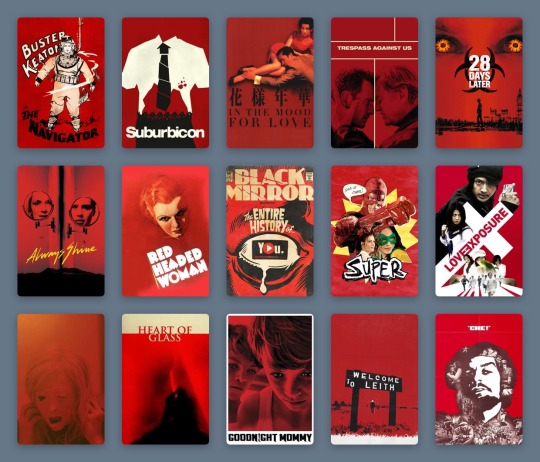
A selection of Gordon’s favorite movie posters.
But when I see these 300 examples, color-coded by typography and accents by Sera Ash, I recognize that white movie posters are the ones most likely, in this very strange time, to take care of me. I see it in three distinct filmmaking periods: Disney animations from the 1940s and 50s, the video marketing for cult comedies of the 1980s and 90s, and the alternative marketing materials of my favorite films of the 2010s. Each poster is straightforward and inoffensive. It captures the story, but never dares to impress or intimidate beyond basic description.
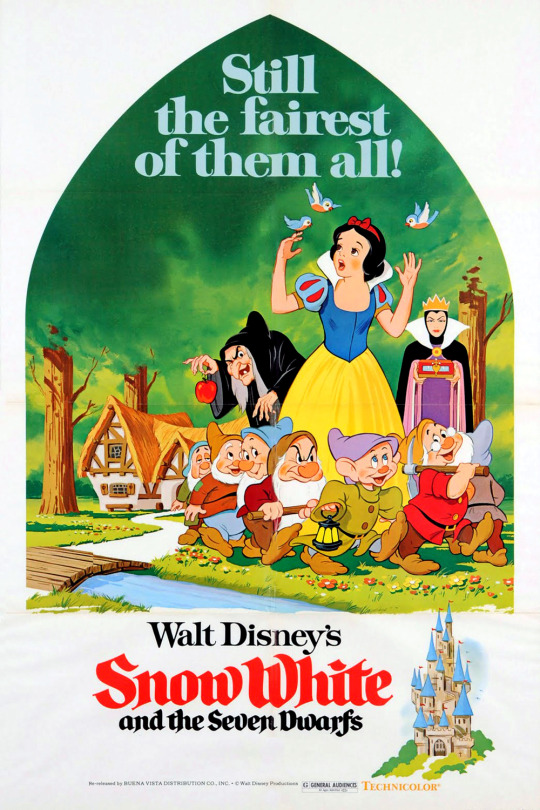
A 1975 re-release poster for ‘Snow White and the Seven Dwarfs’ (1937).
In 1937, Snow White and the Seven Dwarfs announced the birth of Walt Disney’s feature-length empire. While its original theatrical poster is also mostly white, it is represented on Letterboxd by a 1975 re-release poster depicting a peek through the keyhole: a curved triangle framing Snow White, the dwarves, and the two sides of the jealous queen, against a vivid green forest. In the bottom corner, a castle. To the left, the title—her name in red cursive, theirs in black. These simple images come together to present an elementary summary of the ingredients within. The white frame showcases the seminal animation craft without suggesting the viewer diverts their eye anywhere else.
This technique was common across other animated titles, collected in lists like dantebk’s Disney animated classics. Pinocchio toys with the hyperreal relationships between characters alive and wooden, human and animal—but does so on a plain canvas, so that the magic remains within reach. Dumbo, Bambi, Cinderella, Peter Pan—each follows suit. Whether with the mustard yellow of a circus tent, the faint sketches of grass tufts, the gold dust of an enchanted fairy godmother or the ink blue of a midnight starry sky, these colors (indicative of each defining scene-setter or mood-maker) only pepper a blank background, and so make their significance ever greater with the most sporadic touches.

A selection from dantebk’s list of Disney animated classics.
Live-action knockouts from these decades—films like The Shop Around The Corner and The Red Shoes—embrace painted recreations of their protagonists (Margaret Sullivan and James Stewart as festive lovers in the former, Moira Shearer as a tortured ballerina in the latter) and use the color red as a signifier of romance, against a plain white page, to set the mood. Slashes and splashes of red have been used to create a vibe in genre cinema for many decades—a trend deftly chronicled in this list by Rocks.
As far as we know, the underpinnings of digital photography began in the 1950s, and the first published color digital photograph dates back to 1972, when Michael Francis Tompsett shot a photo of his wife Margaret for the cover of Electronics magazine. Consumers got their hands on the gear in the late 1990s, but movie studios really started to make the most of sharp digital photography and stark white backgrounds for their striking posters from the late 1980s onwards. Because, never mind the multiplex, the video store is where you wanted your comfort fare to stand out in the 1980s and 90s.
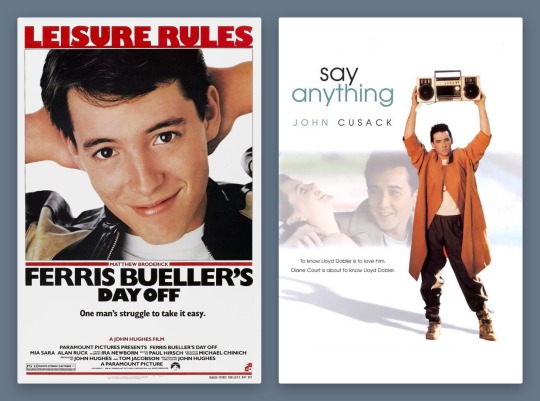
Ferris Bueller’s Day Off (1986) and Say Anything… (1989) form a handsome, trend-setting 1980s pair. While the theatrical poster for Cameron Crowe’s Say Anything… deigned to include John Cusack’s co-star, Ione Skye, by the time of the film’s video release, the focus is clearly on pre-High Fidelity Cusack, as proud underachiever Lloyd Dobler, smouldering lopsidedly under the weight of a boombox. It’s the singular image of the film to this day.
Meanwhile, Matthew Broderick as Ferris-slacking-Bueller is making the most of his title activity, arms behind his head, a proud smirk on his face. Nothing else matters except that these charismatic young stars are stepping up to leading-man status. The white background accentuates the star power of these new boys in town, embracing the limelight in one fell swoop.
Star power is everything: beautiful people doing simple things against empty backdrops, because what could be more important than the regularity of symmetrical bone structure, of familiar charm? The trend boomed in the 1990s and 2000s, in films widely embraced by casual moviegoers. The sort who list “watching Netflix” as a Sunday activity on dating profiles and use the Christmas holidays to rewatch comedies they have memorized over dozens of half-attentive viewings (absolutely zero judgement here!).
The vast majority of these films have white posters. Who is your soothing cup of charm: Tom Hanks on a bench, nothing more nothing less, from 1994’s Forrest Gump? Or Heath Ledger, effortlessly cool, leaning on the brown corduroy armchair Julia Stiles sits in for the 10 Things I Hate About You poster from 1999? (The 90s harnessed the increased appeal of having two lookers just sitting and posing against a plain background, as demonstrated in this chilling list by Ashley.)
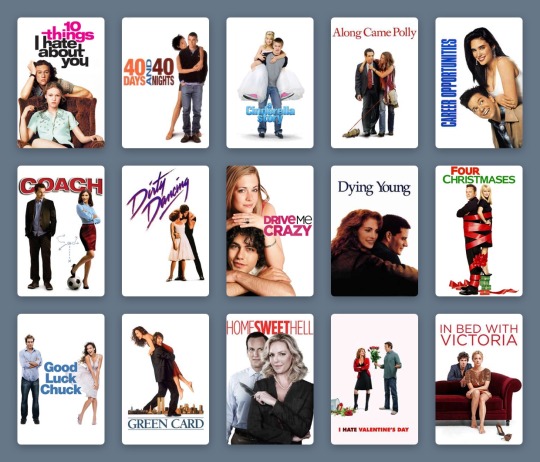
Ashley’s list of couples posing in front of a white background.
Will Ferrell had been earning his stripes as an actor for years, but he changed the movie comedy game as Buddy the Elf in 2003. There’s plenty of visual humour in Elf, but Ferrell’s coat-stand posture bedecked in festive green velvet and those tights is… enough. A white background lets the ridicule slide, just.
How many Disney series really deserve a whole movie—and one that stands the test of time? Lizzie McGuire, resting on her tiptoes with a swinging suitcase in hand, sells The Lizzie McGuire Movie like no idyllic views of Rome ever could. It’s reaching out to an audience loyal to the character, one who will follow her to the ends of the Earth, or at least to another continent. Hilary Duff could be doing almost anything on this poster and it would achieve the same effect—so long as the white background remains plain enough to keep eagle-eyed fans on the main event at all times.
It’s surprising that the star-making system only let Meryl Streep appear in a tiny box, one of four character tiles, on the poster for The Devil Wears Prada in 2006. But the design here taps into 1940s animated sensibilities, giving prominence to a devilish red Macguffin larger than the humans. It still achieves the same function—a glossy, glamorous design with the accessible sell of a quotable, star-fuelled comedy.
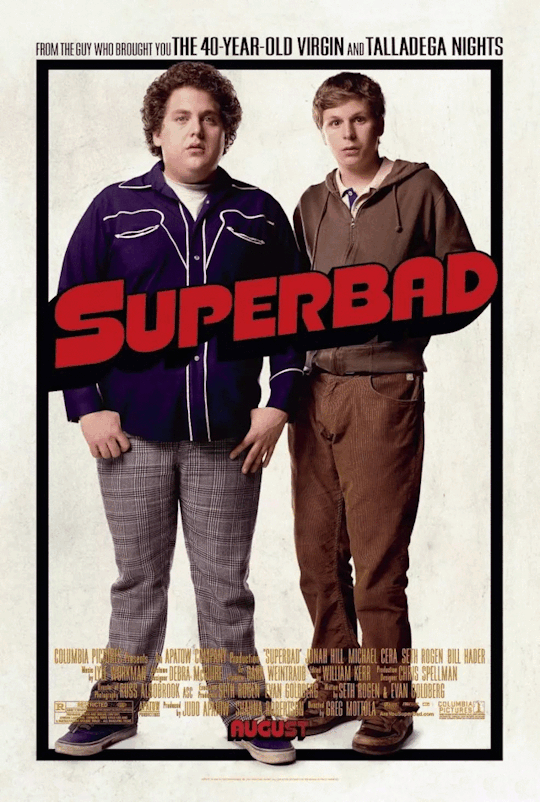
Red may be the color of romance and the devil; it’s also the color of comedy. Exhibit A: the 2007 gross-out comedy Superbad, whose star power—marking the emergence of Jonah Hill and Michael Cera—is used to an opposite and impressive effect on its poster. The awkwardness of these teen boys—lanky, unkempt, insecure—is what cinches the comedy. The simplicity of the poster design, with their uncomfortable posture against, well, nothing at all, further anchors their incapability of facing the world in any confident way, shape or form.
There are countless more examples, like Marley & Me, Bridesmaids, 27 Dresses (notice how the red type is replaced by pink when the film’s plot veers toward the altar). But to understand the curious and timeless appeal of the white movie poster, what happened to it in the 2010s cements its adaptable strength.
As the art of graphic design has continued to bloom, the aesthetic argument for the colorless color-block movie poster has shifted to embrace a film’s context. Consider Danny Boyle’s Steve Jobs, the enjoyable 2015 drama that provided Michael Fassbender one of the most under-celebrated roles of his career, playing the late Apple co-founder. The poster turns the canvas into a blank screen: the title is typed, the text insertion point poised, waiting for the next key press. As Jobs, Fassbender occupies the bottom right corner, in profile, thinking.
This starkness makes sense: what’s next, Steve? It offers a rare example of a poster from the past decade that fully leans into the monochrome aesthetic entirely on purpose—to serve the restrained and unequivocal need for white. (And it’s interesting to compare with the marketing narrative for an earlier film about another tech leader: observe how Jesse Eisenberg’s Mark Zuckerberg eyeballs us from The Social Network’s dark-mode poster.)

Comfort movies don’t own the white poster, of course. Jordan Peele’s Get Out toys, both in its marketing and its delivery, with the binaries of black and white. It’s deployed on-screen with sophisticated horror, and this extends to its two most graphic poster variants.
While one poster sees Daniel Kaluuya’s character, Chris, sat on a chair split vertically between black and white, the all-white poster allows only a center-frame letterbox to reveal Chris’s enormous eyes, accompanied by an all-caps type treatment. The vast expanse of white only makes the image more menacing, framing the claustrophobia so effectively. The landscape crop is a device that defines stern dramas as much as arthouse comedies, as documented by Haji Abdul Karim in their expansive list.
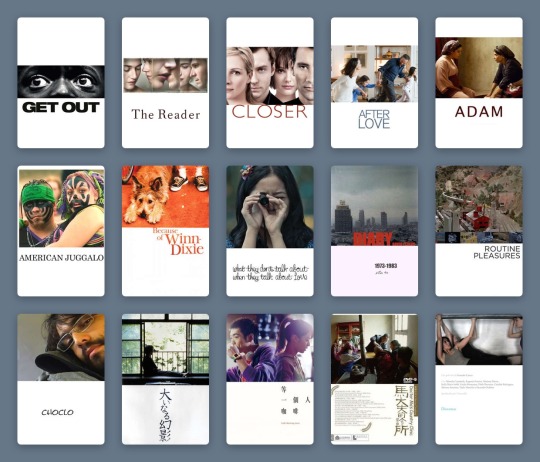
Haji Abdul Karim’s list of white-with-landscape-image posters.
But back in the ‘comfort’ realm, we’re seeing more and more that the marketing wants to have it both ways—the negative with the positive; the art house audience and the multiplex crowd. As genres blend, demographics collapse and audiences become more fluid, a film’s advertising needs to speak more languages.
Two ultra-comfort films from last year demonstrate this idea well. The poster for Judy sees a backlit Renée Zellweger finding her light, receiving her applause. Black is the key color, right down to the classic little black dress; the eye is drawn to the title, spelled out in red sequins. It’s showbiz, it’s drama. Though the film itself fudges a few of the more uncomfortable facts of the star’s story, it’s still honest about her addictions.
In the white-background version, which was more widely distributed, Zellweger, in a floral dress, turns away from the light. The name still sparkles, but in softened gold. There’s no less glamor, the stakes in the film are just as high, but she’s perhaps more accessible like this. The focus, as it was in the 90s, 80s, 40s, returns to the main event.
Greta Gerwig’s Little Women, too, played with dark and light. The indie queen released her previous film, Lady Bird, via design-conscious distributor A24, and Gerwig’s singular aesthetics promised that her Little Women remake would be worlds away from all the others. But when the first images for the film were released, the marketing campaign was questioned by die-hard Gerwig fans.

Both of the group posters are curiously stripped back, freezing Louisa May Alcott’s beloved March sisters in a moment. In the darker image, they gaze out a window, secure in their festive domestic bubble, but set on what’s beyond. There’s more to life, and the film, than this room. It feels more lush, painterly, certainly more dramatic.
Whereas the white poster, at first, seemed like a mistake. It took one of the first images teased from the film and just... dropped it onto a poster. The March sisters look as if solidified by clay, entirely undynamic and at odds with the fluidity and warm soul Gerwig had made herself known for in her filmmaking.
And yet, nothing matters more than these characters. Beth, Jo, Meg and Amy are holding each other, happy, each in their own favourite color, and there is nothing more to fight over. The white-poster alternative lets the 2010s viewer stay attached to the most important part of the film.
The lessons here? A white poster is a vital sign that you’re safe here. You’ve made the correct choice. Attention spans are dwindling, options are expanding, focus is difficult. The promise of a white frame tells me what matters, what is good, where I should place my time and my value. For now.
#movie poster art#poster design#film poster#film poster design#movie marketing#movie design#white posters#comfort movies#comfort films#letterboxd lists#Letterboxd#little women#judy#ferris bueller#disney#graphic design
12 notes
·
View notes
Text
Pinning Down My Kind of Movie
Warning: Wanky, self-indulgent ramblings about Hollywood auteurs to follow
A couple of days ago, I sat down with my housemate to watch Miami Vice (2006) directed by Michael Mann (Heat, Collateral) and starring Colin Farrell and Jamie Foxx. Since we moved into our place, my housemate has gradually been exposed to my taste in movies, and the other day, sat in front of a strung-out Colin Farrell ordering mojitos to ‘Numb/Encore’ during an undercover sting, he finally confronted me with a crisis-inducing statement: “You know, I can’t figure out what your kind of movie is.”
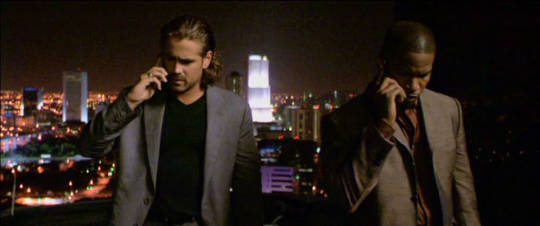
If I am to be totally honest, it doesn’t take much to send me into an existential tailspin, but this observation got me thinking enough to want to sit down and write about it, so here we are. My name’s Daniel and I love movies! When I was a teenager, I was certain I wanted to be a film critic, so I started writing in earnest. The problem was I wasn’t that well rounded as a viewer. I confined myself to the world of comic book movies and Disney animation. I turned my nose up at pretty much everything else before realising that I didn’t actually know much or have much to offer about film. Instead, I turned to music criticism because that’s where my knowledge base is.
That being said, I still loved movies, and as the years have gone on, I have been rapidly expanding my film knowledge and broadened my horizons extensively. I got called a “film buff” for the first time recently, which really shocked me. I still don’t feel well-watched enough, or knowledgeable enough to fit a moniker like that. Maybe it’s imposter syndrome, but I really feel like I have a way to go yet.
My Letterboxd bio includes the phrase “admirer of film nerds”, and I think that admiration informs the entire way I look at the world of film. I read a lot of reviews and listen to a lot of podcasts by smart, unpretentious film obsessives like David Sims, Griffin Newman, Katey Rich, Karen Han and Bilge Ebiri, but that same admiration also informs the kind of films I enjoy the most. In confronting the statement from my housemate, I realised that while there are some genres I gravitate to more than others, my taste in movies is largely defined by the extent to which I can pick up on a single authorial voice driving the film. A director, writer, actor, composer or cinematographer who has a real, obsessive love for their craft whose influence and personality can be felt in every layer of a film’s construction. Franchises are a different beast, but it’s usually the entries in a franchise that feel like passion projects for individual filmmakers that I love the most, which is why Iron Man 3 is by far my favourite Marvel movie.

Over the last few months I’ve started building a fairly extensive Blu-Ray collection. I love physical media because I like to have a tangible representation of the art I love, but it also allows me to physically organise my thoughts about film rather than moving things around on a spreadsheet or in my head. It has also had an effect on how I watch films. Spending money on a film makes me feel more obligated to watch it through to the end in one sitting, to not be on my phone at the same time and to pay closer attention. It’s also made my approach to picking the films I watch more considered. I’ve been hunting down the films I haven’t seen by directors I love, fuelled by newfound completionism, and I’ve been subconsciously prioritising this kind of auteur-driven mindset in a way that has revealed, over time, who my favourite filmmakers are.
So, with that in mind, let’s transform this meandering, self-indulgent think piece into a meandering, self-indulgent listicle. Here are the filmmakers that have changed the way I watch movies:
Christopher Nolan
I know this is a bit of a film bro cliché, but I promise I’m not one of those film school douchebags who’s convinced they’re going to be the next great big budget auteur. Like a lot of other people my age, I discovered Christopher Nolan through the batman movies. I was taken to see The Dark Knight by my parents when I was 10 years old, not having seen Batman Begins, and it blew my mind. For years after that, I was one of those arseholes who had a terrible Joker impression that I whipped out at parties, until I became aware of the cliché and never did it again.
In the years since I’ve watched all of his other movies and gained a new love of Interstellar and The Prestige – movies that taught me a lot about the authorial voice and interweaving a central theme into every element of a film. I also learned that just because I find it annoying when the same tropes turn up in every Quentin Tarantino movie, recurring tropes throughout a filmmaker’s catalogue aren’t universally a bad thing.
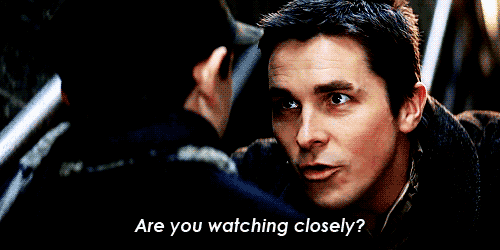
The Coen Brothers
Representation is important. The tough thing about watching films from an auteur-driven perspective is that so many of the most important filmmakers in Hollywood are approaching their films from a white, Christian, male perspective. Scorsese is a particularly difficult director for me to appreciate because so many of his films are overtly informed by his Christianity. My Jewish identity is the most significant aspect of my identity, so naturally I’m always looking for films made from a Jewish perspective, overt or otherwise.
Whilst the Coen brothers don’t always make movies about explicitly Jewish characters or subject matters, their Jewishness always comes out in their writing, particularly in the totally undidactic way they approach the subject of faith in almost every film they’ve made. Their approach to God, fate, spirituality and religion is never one of moralising certainty, but rather a questioning one, which is a fundamental aspect of Jewish existence. I feel represented on multiple levels in the films of the Coen brothers, particularly in Inside Llewyn Davis which is my favourite film of the last decade, in ways that other directors could never manage. For the same reasons I will forever be excited about the potential of the Safdie brothers.
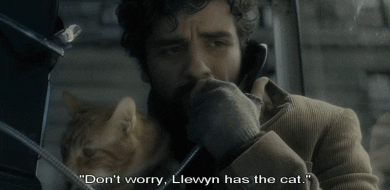
Stephen Spielberg
Whilst the Jewishness of Stephen Spielberg is a major attraction for me (Catch Me If You Can, his moody Christmas movie, comes across as weirdly Jewish to me), the thing that has solidified the guy as one of my favourite filmmakers is his approach to telling true stories. Unlike the Coen brothers, it’s Spielberg’s self-assuredness and didacticism that fuels my love of his work. His spate of recent, politically switched-on, historical dramas (Lincoln, Bridge of Spies and The Post) are all incredible achievements in effectively giving quiet dramas about people talking in rooms the tension and stakes of great action movies.
It’s the obvious thing to say at this point that Spielberg is one of the few genuine masters of the cinematic language, but while most will point to his massive, populist movies of the 80s and 90s as the definitive examples of that, I would point to his spottier late career with its moralising and earnestness as where his most exhilarating work lies.

Michael Mann
I like that Michael Mann is uncompromising. He makes films which, based on premise and star power, should be commercial knockouts, but they almost never are. He has an incredibly clear sense of self, and like Nolan has a lot of frequently recurring tropes in his films. Michael Mann makes films about Men Making Tough Choices™. He builds detailed, intensely researched worlds and he loves crime!
There’s something special when a filmmaker can tread the same ground over and over again and never convey the same central message twice. Nearly all of Mann’s movies are gritty, neo-noir thrillers with an obsessive attention to detail, but all of them deal with a totally distinct existential question which runs through every element of the film, from meta casting to set design, to music, to Mann’s pioneering use of digital photography. I’m just obsessed!

Stephen Soderbergh
Soderbergh is a hill that I’m going to be climbing for quite some time, I think. This is a guy who is relentlessly prolific, taking on a ridiculous number of roles on set himself, and working so fast that he often churns out multiple films in a year. With limited funds and a determination to watch movies legally, my progress through Soderbergh’s filmography has been slow, but I’ve loved every one I’ve watched so far.
As much as I love the guy’s mastery of the heist movie, and the way he slips those story telling devices into a lot of his non-heist stories, I think what really gets me about Soderbergh is the way his filmmaking style always seems to feel tooled towards portraying his characters with as much empathy as possible. Often his films are about people working or learning to empower themselves and coming to terms with their own identities. Anyway, go watch Out of Sight! It’s a damn masterpiece!

Kathryn Bigelow
Kathryn Bigelow’s career is full of insane ups and downs, but as far as I’m concerned, despite the difficulties she’s had getting her movies made and seen, she has three unqualified masterworks: Point Break, Strange Days and The Hurt Locker. On this list of directors, Bigelow has perhaps the most stylistically varied body of work, but her best work, much like that of other directors that I find myself drawn to, is largely concerned with obsession. Her characters are deeply flawed, but unwaveringly driven. What I love is that despite her drastic genre change from pulpy action thriller to hyper-realistic docudrama, she’s managed to hold on to that fascination with obsession, and an acute, outsider’s understanding of masculinity and its fragility.
Kathryn Bigelow has had to adapt to keep working, but because of that, she’s managed to develop a voice and a personality that is versatile enough to withstand her career shifts, but strong enough that it hasn’t been chipped away at by the difficulties she’s faced as a woman in Hollywood.
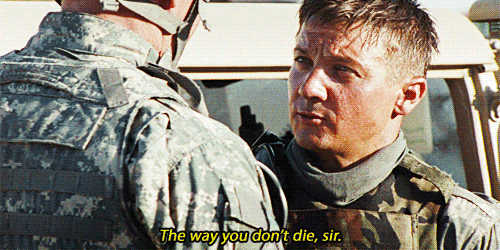
So, what was the point of all this?
Honestly, there wasn’t one. This was a piece of self-indulgence that allowed me to navigate an idea over which I was obsessing for a little while. That being said, I think if I had read something along these lines a few years ago, I would have delved into the world of director-focused movie watching far sooner. It’s hard to quickly and easily define the role of a director in contemporary film, particularly due to the ever growing influence of studios, but in the world in which the above filmmakers operate, the director has final say over all the creative decisions involved in putting together a movie. For me, the most exciting films are the ones that clearly and effectively communicate a single creative voice. Sue me, I love auteurs.
#miami vice#auteurs#christopher nolan#the prestige#the coen brothers#inside llewyn davis#stephen spielberg#the post#michael mann#collateral#steven soderbergh#out of sight#kathryn bigelow#the hurt locker#filmmakers#Jewish film#wanky bullshit
6 notes
·
View notes
Photo
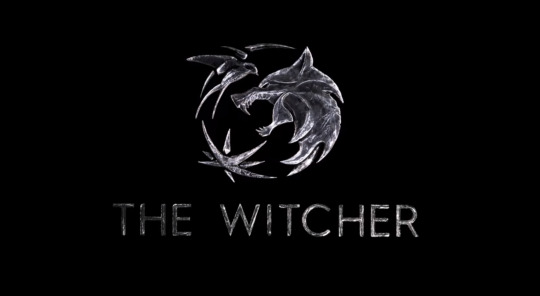
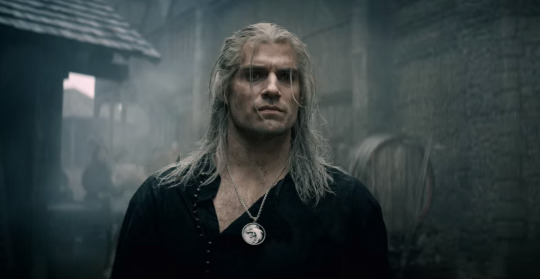



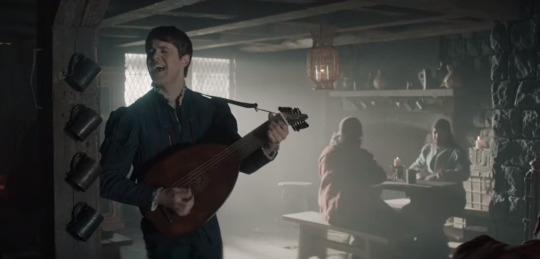

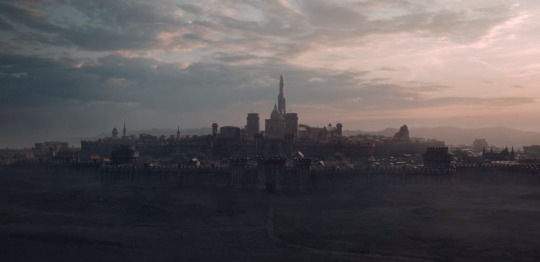


A penny for my Witchery thoughts
The Witcher Netflix series was released at the tail end of last month, giving Geralt of Rivia the interesting distinction of a literary character who’s now a well-known TV protagonist but just happened to achieve international fame through video games first. (Aye, there was a Polish film and show in 2001 and 2002 which called Geralt a “Hexer” instead of a “Witcher,” but they’re not exactly good, though perhaps worth a peek on YouTube for chuckles.)
Geralt’s adventures - both in the stories written by Andrzej Sapkowski and the games developed by CD Projekt Red - are close to my heart. I’ve spilled a fair amount of digital ink writing about the franchise, and my playthrough of the games and subsequent devouring of the books from 2014 to 2016 reignited my appreciation for fantasy and served as the impetus that got me reading more genre fiction and eventually delving into tabletop RPGs in 2017, leading to my current obsession with Dungeons & Dragons. I’m naturally protective of material that means a lot to me, so when the Netflix series was announced I viewed it with only subdued optimism. After all, with the possible exception of a certain HBO thing based on George R.R. Martin’s books (which now seems to be viewed worse in retrospect after the final season), fantasy doesn’t have a great track record on the small screen. I also wasn’t especially impressed when Henry Cavill was cast as Geralt, since I primarily know him from the recent Superman movies, which paint the guy in such a dour light and force him to constantly grimace like someone who’s just taken a dump only to discover that there’s no toilet paper in sight.
But now the show’s out in the wild, and after scanning some mixed reactions (not to mention one truly baffling “review” by two Entertainment Weekly twats who only watched the first episode) I cautiously consumed it with my girlfriend over Christmas break...and can happily report that it’s good. But, it’s also a show that expects its viewers to skip through some mental hoops as we bear witness to three intersecting story lines, all of which are taking place in different eras. Then you’ve got your standard variety of fantasy names, terms and themes, several of which might be tricky to grasp if you’ve never read the books or played the games. For instance, I don’t think they ever bothered to fully explain the “Conjunction of the Spheres” (the time when planets aligned and monsters and humans came to the world, uprooting the indigenous elves and dwarves) or the “Law of Surprise” (when a person’s fate is intertwined with something unexpected - usually an unborn child). I can also see how the show’s numerous mentions of the word “destiny” could seem like wacky dialogue to viewers unaware of the fact that Sapkowski’s realm really does have a strong undercurrent of inescapable fate running through its veins.
Unique structure and terminology aside, the first episode was more of a slow burn than I’d imagined. It starts with an awesome sequence of Geralt fighting a Kikimora, but then transitions into a fairly serious interpretation of “Lesser Evil” from the first short story collection, The Last Wish. The episode then cuts into the exodus of Ciri from the kingdom of Cintra, an event mostly described in flashback in the second short story anthology, Sword of Destiny. The scenes of death and destruction as Ciri flees her burning kingdom are fairly meandering, as are the interspersed interactions between Geralt and Renfri, a woman with seven loyal followers who was supposed to be a grittier version of Snow White in the books. There are some great fights near the end, but as I watched, I couldn’t help but think that I probably would’ve made the opener speedier and a bit pulpier, especially since the tone of these early Witcher tales was more “tongue in cheek fairy tale deconstruction” than plodding epic fantasy.
The second episode also took its time, though the decision to detail the plight of Yennefer the sorceress before she uses magic to change her hunchback form into something that she sees as more conventionally attractive is a good one, since this was once again only flashback material in the novels. But the cream of the hour was certainly Jaskier the bard, who’s going by his moniker in the books rather than the “Dandelion” translation that the games used. He’s played by actor Joey Batey with a perfect blend of magnificent bastard bravado, surpassing his portrayal in the games with a larger than life theme song that’s now something of a cult phenomenon, and his characterization made me feel like the show knew what it was doing at the end of the day.
Episode three is where things truly came together for me, since we barrel straight into the Geralt versus Striga battle from Andrzej Sapkowski’s first Witcher short story. It’s a full-on horror interpretation (which I liked but my girl found too spooky), and also full-on fan service for someone like me who still watches the intro cinematic to The Witcher 1 on occasion. And in later episodes, as my head began getting used to the nuances of the three character timeline, the show seemed to find its footing with this delicate blend of fan service, pulp and seriousness. By the time episode 8 rolled around and the character arcs of Geralt, Ciri and Yennefer came full circle with the Battle of Sodden Hill - yet another event that Sapkowski mostly wrote in flashback - I found myself wishing that season two would arrive sooner than 2021, and my girlfriend felt similarly. I also realized why the showrunners decided on the unorthodox timeline - this is a series that’ll probably excel on rewatches, particularly if you already have an idea of what to look out for.
Series producer Lauren S. Hissrich (who’s quite a joy to follow on Twitter) has mentioned in interviews that this is a show that expects a tad of patience and effort from viewers, but will give a lot in exchange. I’m inclined to agree, and while this depiction of Sapkowski’s lore has some initial roughness around the edges, it ultimately reminds me of how The Witcher 1 was janky even upon its 2007 release but exhibited a unique magic to anyone who stuck with it for more than a handful of hours. Many professional reviewers tend to avoid giving fantasy shows patience and effort (Game of Thrones is an anomaly), which may explain some of the negative reviews. But The Witcher seems to have found a strong-as-nails following from audiences, who made it one of Netflix’s top efforts of 2019, and even friggin’ Anne Rice liked it. (Geralt of Rivia now possesses the other interesting distinction of being a literary character/TV protagonist/video game hero who’s been mentioned in the same breath as Lestat the vampire.)
Speaking of Geralt, I owe Henry Cavill applause. I didn’t think much of his casting, but he pulled through in the end, delivering a silver-haired hero that’s clearly influenced by the games - particularly in the voice and the occasional spell slinging - but still very much his own take, with nary a “where’s the toilet paper” grimace in sight. Audiences can now take their pick between an iconic video game interpretation of the White Wolf and a likely-soon-to-be-iconic TV version, which is a rare choice to have in fandom, especially for a franchise that was once little known outside of Poland. Toss a coin to your Witcher, indeed.
7 notes
·
View notes
Photo



‘Split Enz On The Road’ story written for ‘Rip It Up’ magazine by lighting director, Raewyn Turner. Circa 1982.
“SPLIT ENZ – ON THE ROAD STORY
Raewyn Turner has been lighting director for Split Enz since 1975. She painted the cover for Frenzy and last year at Dennis Cohn Gallery exhibited drawings in her show entitled ‘On The Road Again’. Raewyn has written for Rip It Up, about behind-the-scenes- staging the 1982 Time And Tide tour of New Zealand.
Six months in a leaky boat and that story nears its end for the second time in two years, as Split Enz round the bend on their last lap of touring, finishing in New Zealand. The past five months have been a variety show, the star hosts mingle with us, briefly, from their conveyer belts, flanked by the extras who are directed to have walk-on and bit parts for the day. The many famed and fabled buildings and cities roll on the big rollers past the car windows, and lots of people pass us, in a hurry, to and fro, people with different accents, different smiles, clothes, lifestyles. While we sit and stand, walk and work, moving from car to aeroplane, airport to motel to theatre, the big rollers roll in the world’s projection room, on to the screens, which are our windows.
Split Enz, the audience, the judge, in the van with the video sensurround windows. The selection committee. In a chartered plane, seated in rows until a kind man appears and opens the exit door, ushering us into another windows room. We sit there, breathing in the muted greens and browns and admiring the blue sky, until we’re told to get out and into another room, where soft musak whispers that life is a breeze. Water flows from taps, milk is instant non-dairy whitener, food is but a phone call and an hour’s wait away, all-night television to lull to sleep, air comes from an air conditioner.
10.00 am on Monday, August 16 in Melbourne, and the band are making a film clip, ‘Never Ceases To Amaze Me’, that Noel has worked out with the director over long phone calls from Darwin. It doesn’t finish until 6.00 pm. Last night at the same time, the band had just come off stage, completing the last date of their Australian tour, an ‘Under-18s’ show in Melbourne.
TUESDAY, AUGUST 17
Melbourne, 7.00 am. Grant Thomas, the tour manager, dutifully makes wake-up calls and in six homes scattered over Melbourne, the entourage is busily preparing and packing to make the flight, leaving at 10.00 am to Auckland. 9.00 am we’re at the airport, tired and grizzly, only to learn that the plane has been delayed for five and a half hours. Back home for some more sleep, while the road crew opt to stay at the airport and busy themselves making badges to display their membership of an exclusive social club – the crew’s very own ‘Split Enz Sports And Social Club’ – crew only.
The same day, 10.30 pm, ‘arrive Auckland and proceed to Hamilton, going by the itinerary. Oops. Noel has left his bag at the airport, so we have to double back. Check into hotel, and the band settle for some sleep while I go down to the Founders Theatre to set up for the first show of the NZ tour. The stage set, which has some technical peculiarities, has to be explained and put up and the special effects projectors babied out of their case and wheeled around. Although the lighting plot was sent over a month in advance, the rigging, cabling and colouring of lamps takes forever on the first set up, so we do all but focus tonight. 6.00 am we call it quits and go back to the hotel for a few hours’ sleep. Laurie Bell, the production manager works on, there are many details to be taken care of before the stage and sound people begin work at 9.00 am.
WEDNESDAY, AUGUST 18
Sound check is early, everyone expecs the first show to be difficult because of the new, unfamiliar NZ equipment – PA, foldback and lights. The Finn elders arrive, Finn cousins playing with the beach balls backstage.
The dressing room is newly painted and most of the band find they have severe headaches the next day. But battle dress donned, they take the stage with enthusiasm and anticipation, because it’s great to be on home soil. The audience is quiet, polite and serious. It’s been a whole year since Split Enz toured NZ and they’re playing new material, working hard. There are a few technical difficulties, but only minor ones. Back to the hotel for some hot chocolate with friends, before retiring.
THURSDAY, AUGUST 19
1.30 pm. Wake up, and Eddie and I go down to the theatre to work on improving our computer programmes (Eddie’s synthesisers are digitally controlled and store many different sounds in computer memories). Computers and synthesisers are relatively new developments and computers, like humans, were not designed for the rigours of the road. Just as Eddie wanders around his hotel, wondering where he is and what he is doing there, these computers become similarly vacant and he is often to be found in a state of panic, trying to reprogramme his sounds minutes before a show. The lighting desk computer is but 120 channels of memories which can be reprogrammed for particular lighting scenes or progressions of lighting changes. However, it too has a habit of becoming vacant, or worse, storing more than its share, which means it could reveal the total lighting show at the press of one memory button.
The sound crew have been working all day, trying ti iron out the creases in last night’s sound.
Ed and Noel go off for a walk into town, looking for water pistols. The Ed Water Pistol Collection has swelled to number 120 over three years.
Soundcheck, dinner – Noel enthuses over the six veges – back to the paintstricken dressing room an hour before the show, to put on the ‘cossies’ (costumes), paint the faces, discuss song lists, tell a few jokes, wet the whistle (or sip a lemonade), do armstretches and leg raises, eat some peanuts or whatever is offering in snacks. The show goes ‘averagely well’ (probably ‘very good’ in another’s words), but we have our own rating system.
FRIDAY, AUGUST 20
6.00 am, get up and drive to Auckland. The car breaks down on the way, but is fixed by a kind mechanic, free of charge. We feel that this could only happen in NZ. The production crew have been waiting outside the Logan Campbell Centre since 8.00 am, but the truck doesn’t arrive till 10. They begin work frantically and irritably, but still able to make light-hearted jokes, and the stage set slowly appears.
Meanwhile, Noel has gone to visit his folks. Tim and Neil arrive in Auckland with theirs, to spend the day together. Nigel, being the most boring (he is aware of the fact) member of the band, has experienced nothing of any interest whatsoever since arriving in NZ, not on this day, except for a sleepy interview with Colin Hogg. Eddie visits his sister and his friend Paul Crowther and they spend the rest of the day babbling about synths.
Backstage in the dressing room the champagne arrives – a greeting from the record company. The band have another of their ‘average’ performances, the crowd was ecstatic but the band are tired. The sound men aren’t feeling happy, so they make plans to spend all day tomorrow on improvements, to further dampen the echoes.
Back to the White Heron, now affectionately known as the Red Herring (no offence meant), for a few drinks with friends in the Carriage Bar. This is the first piece of glamorous living I’ve experienced for about a month or more – other people might call it just having a drink – but it means a lot being able to have the luxury of changing from work clothes to casual and being with friends.
SATURDAY, AUGUST 21
1.30 pm. Wake up and with Noel and Eddie go to Parnell Village where we have breakfast with Noel’s folks, who are in Auckland for both shows. A flying visit to a friend strapped in traction in hospital and it’s on to soundcheck and an early show.
Nigel has spent the day sleeping, jigging and walking, his three favourite pursuits. Neil and Tim are having dinner with their folks at the table over from us. They bribe the resident pianist into playing ‘Feelings’ as an after-dinner tribute to the band. (This song was on the top of the list for singing at the top of one’s voice while bumping along in a van through North America.)
SUNDAY, AUGUST 22
9.00 am. Depart the hotel for the airport, 9.55 flight departs Auckland for Palmerston North, without breakfast.
Tim feels detached from everything, and so opts for the hair-of-the-dog treatment, which will see him through until the end of the performance. The drinks backstage in the dressing room are there to be a starter motor, to kick a tired man into action. It’s an early show again, and it feels good to commence the performance about an hour after soundcheck. It’s still early enough to relax afterwards over dinner and watching TV.
MONDAY, AUGUST 23
10.30 am. Bags are being loaded into five cars, room bills are being paid, and we’re off to Christchurch. It’s a day off, everyone is anticipating what they’ll do, and probably they’ll do nothing. We’ve taken all the back seats in the plane and Ian Magan’s (tour promoter) Air New Zealand voice (fondly remembering “Ladies and gentleman, have you seen this?” on flights to London) booms from three seats away. Tonight he has promised the entourage a free dinner.
Eddie and I miss the free dinner – we’ve been invited to his brother’s house. This is one of the advantages of this job – seeing family and friends in all corners of the world at least once a year – where distance and fares would normally prohibit this. The visits are, however, usually too short and sweet.
The band enthuse over the selection of old cars in ‘perfect condition’ being driven around Christchurch, reeling off the makes as we drive around. Austin, Morris, Zephyr, Vanguard… Tim’s been after a Studebaker and is delighted to hear that people in the entourage have spotted three so far. Back home the Split Enz Club boasts a green FJ Holden (Neil’s), a black Mark II Zephyr (Tim’s), a pink Morris Major Elite 1963 (Eddie’s), a 1950 Black Triumph Renown (Noel’s) and a brown 1954 Fiat station wagon (Nigel’s).
Today Noel went shopping and got the costumes drycleaned. Nigel went for a five-hour walk along the Avon, Neil joined the road crew for a trip to the snow, there they used big plastic rubbish bags for sliding down hills and threw snow at each other.
Tim stayed in and did an interview, then cruised around, went for a walk, I think. Ed, Clark Flannigan (Polygram Records’ man on tour) and I finally got ourselves away from the hotel and went swimming at the QEII pool. It’s the first day of the school holidays and Ed and Clark get swallowed up in the crowds queuing for the hydrotubes. Clark can do 50m overarm in 35 seconds, he tries out the high diving board, but Ed and I only manage the lowest. End of day off.
TUESDAY, AUGUST 24
7.00 am. Get up, shower and down to the Christchurch Town Hall by 8.00 am. It’s a beautiful day, warm with blue, blue skies, the smell of blossom, cold air and woodsmoke, peculiar to NZ.
The stage set is constructed quickly and looks good. I’d anticipated, with sinking stomach feelings, that as far as equipment and organisation of technical details go, the NZ section would be the worst and most difficult of this six-month tour (probably because it has previously been that). However, there have been vast improvements made in the expertise of the hired technical personnel and in the equipment to be found here since we toured last year. It has taken a lot of hard work to elevate it to this level, and although the equipment is different to the systems currently available in Australia, this in no way makes for a compromise situation.
At 10.30 am, I offer to get the food – three dozen donuts, one dozen cream buns, three dozen filled rolls, a bag of apples. We work on until 4.00 pm and soundcheck is at 4.30. After a while, the band drift into playing their oldies, searching for the perfect replacement for ‘Hard Act’, which they’re sick of.
The band are tired. After five months of constant touring and only two weeks off in the period – no weekends – they are finding it hellish to think clearly and with enthusiasm about their shows. They want to try a new set, a different way of playing particular songs, but the energy somehow keeps being channelled the same way. They shone for the Auckland shows and will probably shine for the rest, but they try to break out of their feelings of exhaustion and automatic gear.
Tonight’s performance is once again good, although lacking the fire that the band are striving hard to produce. The audience is enthusiastic. The band and crew and managers return to the hotel bar, where we tell each other jokes until the small hours, winding down for sleep after a long day.
WEDNESDAY, AUGUST 25
8.00 am. Woken by chainsaws, jackhammers and the noise of concrete being made in a wheelbarrow. These are quite regular occurrences in hotels where we have stayed, so I drift back to sleep. But Eddie has had enough and has decided to move over to the posh hotel, where Tim and Neil have recently moved, to escape the noise. The hotel is twice the price and offers a complimentary morning newspaper, but we prefer the squat NZ motels, having spent too long in high-rise hotels, with Coffee-Mate (powdered non-dairy whitener) for ea milk.
Soundcheck at 4.30, still the search for the perfect song replacement. ‘In The Wars’, ‘Jamboree’, ‘Under The Wheel’ and a few others are fiddled with and discarded.
Tim, Neil, Eddie and I drive off for dinner and discuss our fatigue and the artistic value (or not) of the song produced under pressure of having to be sold by a record company. The issue of touring arises and they talk about giving it up in Australia and NZ for two years, except for the occasional ‘spectacular’ – an alternative that would provide opportunity for lots of ideas to be exercised. Or perhaps they’d like to do a film, taking a year off to make it and write songs, using that period to develop their musical ability as individuals.
Showtime, the crew are lying around on couches drinking coffee and the first band are pounding away. Eddie is in the dressing room playing his other favourite song, ‘Loving You’ by Minnie Ripperton, accompanied by Neil singing. He breaks away into Chopin.
THURSDAY, AUGUST 26
A day off for some, but the three lighting technicians leave Christchurch at 9.00 am and arrive at Invercargill at 7.00 pm. (The truck has a sleep and they take turns at driving.) The rest of the crew fly down at 11.00 am and spend the rest of the day in the hotel’s spa pool. At 8.00 pm, Laurie, Glen (the set and projects man) and three loaders unpack the truck, having first to remove a fleet of five city council vans that were parked across the stage door. Glen gets to work putting up the stage set and is back at the hotel by 11.00 pm.
Tim, Neil, Clark, Eddie and I have made plans to drive to Akaroa for some fish and chips and scenery, but Eddie and I spend until 2.00 pm buying second-hand furniture for future use, by which time Clark isn’t to be found. The free day has just about slipped away. We make rearrangements with the cars and Tim and Neil go to Akaroa. Noel, Eddie and I take a drive that meanders along a peninsula beyond Lyttleton, and we end up driving along a tractor path up a mountainside. The green pastures, trees in blossom, the mountain and valleys, we can’t wait to settle back here and enjoy the countryside. Tim and Neil return with tales of spectacular scenery, quite in awe of the beauty of the countryside. Neil, in surprise, says it’s always so much better than he’s remembered. Of course, all this talk about ‘nature’ crops up in our conversations especially after a few months on the road, staying in orange and purple hotel rooms. At the same time, the touring lifestyle has another advantage – it provides the blinkers and forces a total commitment to work.
FRIDAY, AUGUST 27
9.00 am. Wake up call from Grant, we move quickly and tiredly into the day.
Arrive Invercargill and greeted by an over-officious officer on the sidewalk at the airport. Magan has an argument with him and Neil throws him a coin as we drive away. Later, Magan receives a speeding ticket from the same officer.
Stop off on the way to the hotel, at the art gallery for a typical photo of the band posing next to a huge anchor for the local papers.
I go straight to work. The crew, having become accustomed to the equipment, are working very fast these days and focus is early. The set works well in the Civic Centre, because the tiers of balconies tower over the stage, which is shallow and therefore the sail has a steep incline. I don’t have a good show, getting my fingers jammed in the faders, despite a grand performance by the projector operators, Glen and Keith, who are by now quite skilled.
Noel apparently just about falls backwards off his drums, fatigued and the rest of the band are tired. But there are only 11 more shows to do, so they attack each one with enthusiasm.
After the show, the musos’ club is less than hospitable, hassling the band at the door. Eddie, Tim and Neil leave and end up helping Magan, who is hosting a three-hour radio show.
The road crew have busily packed clean socks for the Saturday soundcheck before heading off to Queenstown in search of the thrillseeker jetboats. Bed.
Part two of this feature will appear in next months ‘R.I.U’.”
2 notes
·
View notes
Text
01/06/2019 DAB Transcript
Genesis 13:5-15:21, Matthew 5:27-48, Psalms 6:1-10, Proverbs 1:29-33
Today is the 6th day of January. Welcome to the Daily Audio Bible. I am Brian and it is a pleasure and it is a joy to be here with you as we do this for the first time, we reach out our hand, we grab the knob, we turn it, we push forward, and we walk through the threshold of a brand-new shiny, sparkly, new week and I will remind us of this probably more weeks than not because it is a line of demarcation, like it is a new week, which gives us the opportunity to release the previous week because it has become a part of our history and we can look forward to the new week because it has not yet been lived and it is shiny and sparkly and new. And we stand here at the threshold of this new week and we get to decide how were going to live into what comes next. And when we systematically remind ourselves that His mercies are new every morning, and that we remind ourselves of these new weeks then we get a chance to reflect not only on the past week and how we managed it, but what we’re going to do to properly align ourselves with the Scriptures and with the Holy Spirit's guidance in our lives in the new week. We have a much better chance of succeeding if we pre-decide how we are going to do this, right? A plan is always a better thing than winging it. And, so, we make the plan to step into this new shiny, sparkly, new week and walk with God in every moment and in every conceivable way and watch what that does to this week. And one of the ways we do that is to immerse ourselves in the daily rhythm of the Scripture. So, I guess the lesson as we’re moving into this new year for a Daily Audio Bible right now is that we should pay attention to the brand-new weeks that come our way as opportunities for reset and restarting and one of the things we do as each beginning of each new week, we switch translations and read from another translation, which then gives us a comprehensive view over the course of a year of all that biblical scholarship and translation has to offer us. So, we pick up where we left off, but we just switch translations each week and allow those translations and those translation teams to allow God's word speak to us. So, this week we’ll read from the New International Version and we’ll pick up where we left off yesterday. Genesis chapter 13 verse 5 through 15 verse 21 today.
Commentary:
Okay. So, in the book of Genesis, just to kind of keep us attached to the story that's being told, this man named Abram is going to become a very, very, very important figure and it's probably not too much of a spoiler alert that he will have a name change. And, once he does a bunch of stuff will click into place. This man who has followed this God that he did not know into a land that he had never been influences the world until today and deeply affects three of the world's religions, two of the greatest number and that would be Christianity, Islam and Judaism and they all trace their roots back to this guy. And, so, we’ll watch this unfold as the story goes forward but even as we consider Abram going after his nephew Lot who had been taken captive and that he chased him all the way as far as the city of Dan and beyond, these geographical landmarks that we just kind of go by them, there just places in our imagination, they're not. No, they’re actual places. And, so, the ancient Canaanite city gates of the city of Dan, which had other names before Dan, but these ancient city gates that probably Abram would've had to pass through, they’re still standing, some of the oldest gates in the world. And in February, late February, we’ll be going on an adventure to the land of the Bible. Of course, that's all full. It's been full for over a year, but we go into the land of the Bible and we do this virtually every year. And, so, like, even the gates that I just told you about, as we travel through the land of the Bible visiting these geographical locations where the Bible happened, yeah, we’ll be posting that all up, so you’ll be able to see all of this and the trip becomes virtual. So, so many of the places that we’ll visit in the Bible are actual places and you’ll be able to see what they look like. If you want to kind of jumpstart on that there is a resource in the Daily Audio Bible shop, it’s called Promised Land, the Essential Pilgrim's edition and it is a double DV set that also comes with an instant digital download and there's over four hours a content. I’ve been shooting in the land of the Bible for…gosh…I think six years in a row to amass one of the greatest collections of the landscape of the Bible that exists. And, so, a lot of this is incorporated into the promised land films and what they are is just like two to three-minute short films and each of them is a location and they’re kind of organized by where they are: North, South, East or West in the land of the Bible. And, so you can see these things for yourself as we move through the Bible, you’ll be able to zoom in, watch a quick short film, if that’s what you want to do, and immerse yourself even deeper in the geography of the Bible so that you sort of have a lay of the land as we’re reading these the stories. My whole life I was raised around the Scriptures, I was raised as a pastor son, so these stories, you know, the more famous stories in the Bible were stories I grew up knowing and I always just imagined them and then even as an adult when I kind of returned to the Bible and it became part of my life I still just kind of imagined them. And then finally after many years of being invited I went and I this is like alonmst a decade ago now, but, you know, I didn't….I just thought it was gonna be kind of gimmicky and I just didn't want to go. I thought that it would maybe even mess with my faith in a bad way. I don't know…I just imagined, you know, a place where Jesus did something important in the Scriptures across the street from a McDonald's or something. I just didn't want to see that. That’s not how it is though. And, so, you can see. You can see the land of the Bible with the Promised Land films. That’s over four hours of content and will definitely set you up as we move through the Bible. So, you can check that out, but we will be going to the land of the Bible virtually next month, late next month. So, we’ve got some time and that's always a fun community experience.
Prayer:
Father, we thank You for Your word, we thank You for the story that is beginning to blossom and unfold before us as we begin to know some of these main characters that are our spiritual ancestors and begin to know their story and begin to understand that their story connects to our story and even as Jesus, we are listening to Your words that we now call the sermon on the Mount. I’m pretty sure that's not what You wrote at the top of Your notes when You decided to give this message, but this is what we call it and we’re listening to it and it's a deeply challenging thing. We’re right here at the beginning of the year. You begin to press in on us with the truth, You begin to come…we always are inviting You near not understanding that that's not just a sense of comfort, like draw near to me Lord so that I can feel better about whatever's going on in my life and I can feel comforted and I can feel like You’re gonna be here to beat up the bad guys in my life. Sometimes when we pray that You will draw near You do draw near and it confronts us with things that cannot stand in Your presence that are in our lives and this is what we begin to find as we read that what You're telling us in the sermon on the Mount. So, come Holy Spirit, plant the word of God in our lives, interpret it for us into our own contexts and stories as we walk with You and humble ourselves and surrender our agendas, we invite You through Your word to speak on Your own behalf. Come Holy Spirit we pray. In Jesus’ name we ask. Amen.
Announcements:
dailyaudiobible.com is the website, its home base, its where you find out what's going on around here
And I mentioned the Promised Land films just a minute ago. I mean, you can check out all of the resources that are in the Daily Audio Bible shop at dailyaudiobible.com. We have collected and continue to do that, to collect resources that are tailor-made for the journey ahead, the journey through the Bible in a year, companions to take you on that journey and accompany you through that journey as you move through the Bible. So, the Promised Land films are certainly that but check it out. Check out the resources that are in the Daily Audio Bible shop as we move forward through the Scriptures.
If you want to partner with the Daily Audio Bible, you can do that at dailyaudiobible.com. There’s a link on the homepage. I thank you profoundly and humbly that if this has been life-giving to you over the years are over the last week, if life is coming into your life because of the word of God, then thank you for your partnership. What we've done as the Daily Audio Bible and this won’t be the last time that I say this…I mean we’re entering our 14th year and this was never launched out of some big ministry somewhere. This this grew up out of a prompting and some obedience and out of the dust of the Internet and we've been a community ever since. And, so, what we've done over these years has been done together and everything that will be done as we go through this year will be done because we did it together. So, if you want to partner with the Daily Audio Bible, thank you profoundly and humbly, thank you. There’s a link on the homepage. If you’re using the Daily Audio Bible app, you can press the Give button in the upper right-hand corner or, if you prefer, the mailing address is PO Box 1996 Spring Hill Tennessee 37174.
And, as always, if you have a prayer request or comment, 877-942-4253 is the number to dial.
And that's it for today. I'm Brian I love you and I'll be waiting for you here tomorrow.
Community Prayer and Praise:
This is Michelle from Gettysburg. I am listening to Brian’s reading from the 31st and just praying in Thanksgiving and I think to myself, how many days this year did I just think that something wouldn’t go or God wouldn’t pull through or how is it going to turn out and here we are on the 365th day of our reading and God is faithful. God is just always faithful. So, maybe you didn’t go the way we thought or maybe things didn’t work the way we wanted them to, but God had a plan. And, good or bad in our minds or our ideas, God was good, He was good all the time. And that is a praise. Even if my mom’s health isn’t exactly what I want it to be or there was a loss this year and all the prayer requests that came over, they weren’t always happy ones and there were many losses but we forged forward and we just took the next step and we just showed up, and we showed up for the readings and we showed up for God’s word and we came because we knew He was faithful. Somehow all of our stories line us back up showing thanksgiving, showing praise, and showing up. So, by the time this gets played it’ll probably be day three of the new year and we just started and took the next step, right? I thank you Daily Audio Bible people showing up, for knowing God is faithful, for knowing that in another 367 days we will be back here praising and thanking Him again as we should each day. I love you.
Dear Holy Spirit thank you for being with me, thank you for being with us and giving us this precious community of believers. On this last day of 2018 I am contemplative as Brian said so eloquently today in his reading, contemplative especially of this new word of the year, “Maintain”. And Lord, I ask that you help us as you always do Lord as we lift ourselves up to You every day and help us to maintain the hope, the hopefulness that You are. Help us to maintain the love that You give and that You have placed in our hearts as believers in Your son Jesus Christ. Help us to maintain the trust in You in knowing that You are everything, everything in our life, and if we maintain that trust and keep You first and foremost, in all things, in all thoughts, in all words and in every day, that You will keep us in the palm of Your hand and bless us exceedingly. Help us to maintain the faith in You always. And I am so grateful for Brian, Jill, Asia…China…I’m sorry…China and I just love all of you and thank you so much for this blessed community. God bless you. Happy new year.
Good morning daily Audio Bible family, this is Dmmy from Dallas Texas. This is my second time calling this year and this year is my first year completing the entire Bible. Of course, I missed some days but I’m going to do it over again for 2019. Have a happy new year everybody.
Good afternoon Daily Audio Bible community. This is Diane Olive Brown from Newburgh Indiana calling on December 31st at 4:12 PM and I have something I found that I think will really encourage your faith. It’s called Authority and it’s an anonymous…I don’t know who did this but it’s really great. When mountains will confront the way like it and leap, arise and say be thou removed and they shall be by the power of God capped in the Sea. All the power on earth, all the power in heaven to Christ, the son of God is given and from the throne He will endue and hindrances will flee from you for all the power of being that man faith through the Lord I surely can. Faith from his power on earth to tread on serpants __ on dragon’s heaf. Where though are oh mountain high, where there though art in earth and sky, when there though art truth is the same be thou removed in Jesus’ name. Be though removed faith will restart for yonder sea arise depart. I may, I can, I must, I will, the purpose of my God fulfilled. Isn’t that wonderful? We have a purpose and we shall fulfill it. Shalom shalom.
Good morning Daily Audio Bible family it’s January 1st. Happy new year. Let’s pray. God please give us the confidence to trust You to charge how things are to how You want them to be in our lives. Only You God can do that, and nothing is impossible with You God. We ask for the commitment that we need to take action. Lord, we pray that we may count our days with wisdom and realize how every day counts in the light of eternity in the saddles of our hearts. Watch over our hearts Father God. Let us ask ourselves in every situation what will this do to my heart. Help us measure our days and let us always ask ourselves, what is this going to do for my life and what is this going to do for my heart in my daily decisions. Please give us a discipline and joyful life Father God did help us to remember that our joy is in You. Help us to have a meaningful life and let us abound in pleasing You God. In Jesus mighty and precious name we pray. And we pray this prayer for all of us, especially for our children and those that are struggling. In Jesus mighty and precious name we pray. This is Nydia from New Jersey. I love you.
3 notes
·
View notes
Photo

MIAMI ART WEEk 2018
(photo of Scouted Artist, Johanna Boccardo by Matt Rice Photography)
It’s the most wonderful time of the year! Miami Art Week 2018 is almost here. From December 4th through December 9th, Miami will be taken over by art collectors, gallerists, artists and celebs for the 17th installation of Art Basel Miami Beach. With the addition of 15+ satellite fairs and art related events, it is an overwhelming territory to cover in just 6 short days. As such, we’ve put together a quick guide to help you tackle the week.
If you have one day or if it’s your first time, you must see Art Basel at the newly renovated Miami Beach Convention Center. This year’s event is set to take place December 6th-9th. Grab a glass of champagne and peruse 267 of the world's leading modern and contemporary art galleries displaying premier paintings, drawings, sculptures, installations, prints, photography, film, video, and digital art by over 4,000 artists. This show is like going to one of the world’s finest art museums. The most recognizable artists, such as Twombley, Calder, Basquiat, and Bourgeois, are usually at the front of the show while the newer “up and coming” artists are towards the back. The added twist that everything is for sale lends a real air of excitement to the room. In 2017 Art Basel offered over $3.5 billion in art for sale. In addition, there is great people watching between the celeb sightings and general audience attire. Spotted last year were Drake, 50 Cent, Jaime King, Cindy Crawford and Val Kilmer to name a few. The hot ticket is the Preview party on Wednesday night, but best of luck getting in to this invitation-only event. The fair opens to the public Thursday, December 6th at 3 PM. Tickets are $50 online, $60 onsite.
If you have an extra day or are feeling like getting an ambitious start to Miami Art Week, ART MIAMI and CONTEXT open to the public on Wednesday, December 5th at 11AM. Located on the mainland at One Herald Plaza between the Venetian and MacArthur Causeways, Art Miami showcases significant works of art from 20th and 21st century artists. Here you can see a few of the high end pieces that you may find at Art Basel - works by Jim Dine, Roy Lichtenstein or Helen Frankenthaler to name a few - but will also see more works of young, emerging artists and galleries. Sister fair, CONTEXT, highlights newer and cutting edge artists. Together, these fairs are very manageable and parking is easier than on the beach. Much of the art is priced a little lower, starting in the $25,000 range. Plan to spend about 4-5 hours between the two tents. One day passes are $55.

(Photo of Emma Repp’s drawing at the SuperFine art show in October 2018)
Feel like adding a third or fourth day to your Art Week? There is definitely more to be seen. Head back to the beach to take in ART PULSE, UNTITLED , SCOPE MIAMI BEACH , and SUPERFINE . ART PULSE opens to the public on December 6th at its beachfront location at 4601 Collins Avenue. I’ve ‘discovered’ some of my favorite artists here including Jordi Alcaraz and Eva Sussman. You can pick up a piece of art here starting around $7,000. Tickets are $25. UNTITLED, located between Ocean Drive and 12th Street, opens December 5th. Tickets are $35. In addition to contemporary art, visitors to Untitled can see an ongoing performance of #NeverNotWorking which invites everyone to assess their privilege by highlighting the plight of domestic and service workers in the United States. . Then a little further South, Scope Miami Beach enters its 18th year and celebrates international emerging contemporary art and multi-disciplinary creative programming. This fair is located at 801 Ocean Drive and opens to the public on December 5th at 11AM. Tickets are $40. Just next door at the Art Deco Welcome Center is SUPERFINE! Open December 5th-9th, SUPERFINE! features artwork that is affordable and representative of the local art scene. Tickets are $8-$10 depending on day.
Looking for the Next Big Thing? Then you must check out NADA . The 16th edition of this fair will feature over 124 galleries and will take place from December 6th-9th at the Ice Palace Studios. NADA was founded in 2002 and is is dedicated to showcasing new art and to celebrating the rising talents from around the globe. Tickets are $20.
DESIGN MIAMI opens December 5th. This fair features museum quality exhibitions pertaining to interior design. Don’t miss this year’s commissioned piece by contemporary artist Pedro Reyes and fashion designer Carla Fernández which will feature curved steel walls and a map that shows the names of the more than 300 original settlements on pre-Columbian Americas. Design Miami is located next to Art Basel at Meridian Avenue and 19th Street. Admission is $27 online, $32 onsite.
I love works on paper and if you do too, don’t miss INK MIAMI . This fair is unique among Miami’s fairs for its focus on modern and contemporary works on paper by internationally renowned artists. The Old Print Shop, Tandem Press and Durham Press are a few favorites. INK Miami is located at the Suites of Dorchester, two blocks north of 17th, and opens on December 5th at 9AM. Admission is FREE. While you are there, travel 3 blocks south and check out AQUA ART MIAMI Featuring 52 galleries from around the world, this fair opens December 6th at 12PM and is located at 1530 Collins Avenue. Admission is $25.
Spectrum Miami and RED DOT will return to Wynwood this year with shows focusing on certain themes. Spectrum features an international slate of artists and galleries as well as five days filled with Art Labs, Art Talks, Meet the Artist sessions, music, and entertainment. This year’s curatorial theme is Allure which will be demonstrated through atmospheric abstracts, provocative photographs and seductive sculptures. Sister fair, Red Dot, showcases over 75 galleries who will be curating around this year’s theme, Illuminate. These fairs, located at Mana Wynwood, run December 6th-9th. Admission is $25.

(Photo by Zach Balber, curtesy of Bass Art Museum: The Miami Mountain)
All of these fairs have opening night previews. If you have a friend in the know, try to score an invite as these times can be far less crowded. Otherwise, here is a suggested schedule for the general public days:
Wednesday, December 5
ART MIAMI + ART CONTEXT at 1PM. Check out works by TSG Miami featured artist, Carola Bravo at Bernice Steinbaum Gallery’s booth at Art Miami. End the day with a glass of sparkling rose and lobster deviled eggs at Migonette.
Thursday, December 6
SPECTRUM + RED DOT at 1PM. Refuel with a Taco Alambre at Coyo Taco and a coffee from neighboring Panther Coffee and head south to NADA around 5:00PM. Finish the day with drinks and gorgeous views at Cipriani’s when the fair closes around 7PM.
Friday, December 7
DESIGN MIAMI at 11AM followed by ART BASEL at 3PM. Grab lunch at the Garden Cafe by Michelle Bernstein, located at the adjacent Miami Botanical Garden, and pop into INK MIAMI in between.
Saturday, December 8
ART PULSE at 10AM + UNTITLED at 2PM + SCOPE MIAMI + SUPERFINE!. Slip out the back of Art Pulse and take the boardwalk to La Côte at the Fountainbleau for lunch with a beach view. Head south to Ocean Drive for the remaining 3 fairs. You can catch up with TSG Miami featured artist, Jamie Jones, at Superfine! (Booth B04.) Then, finish the day with the late night Happy Hour at The Upland. We recommend an Upland Old Fashioned and Crispy Duck Wings to nibble on!
Sunday, December 9
Revisit your favorite fair from the week and make a last minute deal on a piece before the gallery packs it up! There are also many other events hosted by individual galleries and museums. TSG Miami featured artist, Liv Dockerty will have a pop gallery in Coral Gables at 279 Giralda Avenue while Johanna Boccardo will be part of a group show titled “Mis-placed” at Collective 62.
For more comprehensive list of fairs, collections, and events, click here
#miamiartweek2018#artbasel2018#artmiami2018#artbaselschedule#miamiartweekcalendar#scope2018#pulse2018#designmiami2018
2 notes
·
View notes
Text
Shooting with a 21-Year-Old Camera: The Fujifilm S1 Pro
I find it incredibly fun to use older, especially unique, digital cameras both as a challenge and for sheer enjoyment.
I think part of it is psychological. With archaic cameras sporting outdated technology we anticipate subpar results, and so we focus more on what we can control: composition, lighting (when applicable), exposure, and so on — the things we should always be focusing on.
Conversely, when we have a Hasselblad in our hands, we may let go a bit in the unconscious belief that the camera can make up the difference for our lack of talent or effort. Of course, we all know it can’t.
I won’t get into the boring history of why I own a lot of early to mid-2000s digital cameras, but at some point, I found myself the owner of a Fujifilm Finepix S1 Pro — the first in a five-model line of Fujifilm DSLRs that housed some incredibly unique sensor technology that it dubbed “SuperCCD.”
Apologies for the subpar product photos. I didn’t have access to my full setup.
In the S1 Pro, the photodiodes of the 3.1-megapixel SuperCCD sensor took the form of a honeycomb tessellation, oriented in a zig-zag array rather than a simple vertical/horizontal mosaic. Because of this, the distance between cells is smaller, making for about 40% more (square root of 2 = 1.41) sensor cell rows horizontally and vertically than a regular Bayer sensor.
The camera then uses an interpolation algorithm that supposedly results in a resolution equivalent to a 6.2 megapixel Bayer sensor. The 45-degree orientation also allows for improved capture of horizontal and vertical detail. This is good because most of the world, thanks to gravity, exists in horizontal and vertical planes — however, this happens at the expense of diagonal resolution, which is where traditional sensor layouts excel.
The honeycomb design of the SuperCCD sensors.
Released in January 2000, the Fujifilm S1 Pro is based on the Nikon N60 (aka F60) film camera body (with modifications by Fuji). It logically sports a Nikon F mount and can use AI, AI-S, AI-P, AF, AF-D, or G type lens — however, only AF and AF-D lenses will autofocus. AI and AI-S lenses can only be used in manual exposure mode as there is no meter coupling.
Most of these photos were shot with either the Nikon AF-D 24-120/3.5-5.6 or Nikon AF-D 50/1.8. While the 24-120 is not a quality optic, it’s a more than sufficient match for this sensor, especially stopped down a bit — and you can stop down to your heart’s content without hitting diffraction on this camera.
I had initially gone out shooting with some superior G-type lenses, however, accurate manual focusing is impossible for me through the straw-like OVF (wearing glasses doesn’t help either) and the focus confirmation dot is totally unreliable. Strangely, I had more issues manually focusing on distant objects stopped down than closer ones wide open — the photo above was manually focused with the Sigma Art 35mm wide open at f/1.4, yet the below photo (slightly out of focus) was at 24mm and f/8 with the Nikon 24-120mm f/4G VR.
Shutter speeds top out at 1/2000th. There are several metering modes (3D 6-zone, 6-zone, center-weight), a pop-up flash and hot-shoe (Nikon TTL compatible), and ISO options of 320, 400, 800, and 1600. There is no auto ISO function, and you have to menu dive each time you want to adjust it.
File choices are JPEG or TIFF only — no RAW, unfortunately — recorded to either CompactFlash or SmartMedia. The camera certainly did not accept my 64 or 128GB cards, but I was able to dig up an old 1GB card that can hold a whopping 56 TIFF files in the highest quality mode available (“Hi RGB TIFF”).
This is easily the slowest camera I have ever used. The menu is the antithesis of intuitive; it’s mostly just a collection of symbols and abbreviations and my hat is off to you if you can guess their meaning without reading the manual.
Forget chimping. Just murder that idea and bury it. It takes a solid 31 seconds (yes, I timed it) for an image to populate the screen. Once it does, just about the only thing you can confirm is that a photo was indeed taken, though a histogram is available for more accurate analysis. JPEGs, however, are significantly faster to review.
In a way, if you choose TIFF over JPEG, using the camera is akin to shooting a bulked-up Nikon N60 loaded with a roll and a half of film — no image review, roughly 55 maximum shots, and no quick adjustment of the ISO.
The S1 Pro allows you to choose between either 3.1MP or 6.2MP output. To produce a traditional image file — which exists in rows and columns — the camera must interpolate by using adjacent photosites to generate data between existing pixels. After all, the recorded file can’t exist in the same zig-zag honeycomb pattern as the sensor. After each line is read out and the missing data is filled, you end up with twice the spatial resolution (6.2MP).
Compared to the Nikon D40, which uses a 6.1-megapixel Bayer sensor, the S1 Pro doesn’t quite reach the same level of pixel acuity. However, side by side with the 4.1 megapixel Nikon D2Hs, there isn’t much in it between the two. So, I think the real Bayer-equivalent resolution sits somewhere in the middle of 3.1 and 6.2MP — around 4-4.5 megapixels. As it would happen, this is exactly in line with the roughly 40% increase in sensor cell rows (3.1 * 1.41 = 4.37). It also depends on the scene — some benefit from the unusual sensor design much more than others.
CCD sensors are not forgiving of sloppy exposure. Pushing or pulling can quickly result in blotchy chroma noise, severe color shifts, and compromised roll-off from the quartertones into the highlights. It is not unlike slide film in this way.
The colors are phenomenally accurate and neutral out of the camera. “ORG” tone and color produce a lovely, neutral file that’s perfect for editing, and “STD” (standard) tone and color make for a pleasingly usable straight-out-of-camera file. Even with color set to “HIGH” and tone set to “HARD,” the images aren’t bombastically oversaturated and Disneyland like we often see with the “Vivid” setting in modern cameras. In fact, High Color/Hard Tone photos exhibit only a very modest bump in saturation and contrast compared to Standard Color/Tone. One thing is perfectly clear: Fujifilm was producing cameras with beautiful color output long before X-Trans.
All the images here were shot at ISO 320, 800, or 1600. ISO 400 is completely pointless given that it’s a mere quarter stop gain over base. It would be easier to just dial in a third of a stop of exposure compensation rather than clicking through the menu. I really wish there was a lower base ISO of 160, as well as intermediate options like 640 and 1280.
The camera’s high native sensitivity — combined with early CCD architecture — means that there is a noticeable level of noise even at base ISO. Thankfully, the noise is quite pleasing and mostly luminance up through ISO 800 — even 1600 has very minimal chroma noise straight out of the camera. Anecdotally, I’ve found this to be a running theme with CCD sensors — considerable noise even at base ISO, but the noise presents very favorably through most, if not all, of the sensitivity range depending on the camera. It also makes for astonishingly appealing black and white photos, especially given the finely grained texture from what is largely high-frequency noise. “Film-like” would be an apt descriptor for the results.
The considerable noise in this image is the result of bringing up an underexposed photo in post. Black and white helps cover the color shifts and chroma noise.
If you nail exposure in camera, ISO 1600 will produce remarkably great results with an unexpectedly low amount of noise for a sensor of this type and age — there isn’t much to speak of in terms of offensive noise and photos are completely usable without any noise reduction. However, at this point, you’ve lost a good bit of dynamic range and if you try to push the image in any way, blocked up patches of low-frequency chroma noise and banding immediately rear their head. There is essentially zero room for pushing the files at all if shot at ISO 800 or higher.
Quite impressively, there is almost nothing in terms of color shift throughout the entire sensitivity range — what is accurate or pleasing at base ISO will be accurate or pleasing at 1600. Again, this is something I have noticed on more than one occasion with CCD cameras — the Pentax 645D behaves almost identically throughout its ISO range.
ISO 1600, SOOC “Standard” color and tone, auto WB. Noise reduction and sharpening zeroed out in ACR. No adjustments aside from downsizing.
While restrictive by modern standards, a highly usable ISO 1600 in an APS-C camera in the year 2000 was exceptionally good. Fujifilm claimed the SuperCCD cameras to have superior sensitivity performance — the honeycomb photosites allow for more pixels to be packed within a given area and their shape more closely mirrors the circular microlenses that sit above them. I think Fuji’s assertation bears out in practice.
I would estimate roughly 7.5-8 stops of usable dynamic range, which is up against what I presume is an 8-bit ADC (analog to digital converter). Given this, along with the unforgiving nature of CCD sensors and processing latitude further limited by the lack of RAW, you need to be very deliberate with your exposure choices. Even in a scene of moderate contrast, you will almost certainly have either crushed blacks or clipped highlights.
However, like most CCD cameras, you do start to lose dynamic range quickly once you boost the ISO by a couple of stops. There also isn’t much in the shadows — modern cameras (CMOS) tend to have a lot of their dynamic range bunched up in the shadows, allowing for some truly incredible detail recovery. CCD sensors do not work the same way, and even with a full-blown RAW file, I doubt you’d find much usable information at that end of the histogram. You can mitigate this somewhat via ETTR (“expose to the right”), but with what is already a suboptimal amount of dynamic range, you’ll only have a small amount of latitude for ETTR, if any.
Oops, highway patrol got me. High contrast scenes like this are difficult – the whites are just on the cusp of clipping, but the blacks are gone in numerous areas.
While the camera’s light meter, particularly the 3D 6-zone multipattern meter, is exceptionally adept at balancing exposure in difficult scenes, the auto white balance is a duality: it’s either one of the most accurate I have ever seen or it’s the worst. Almost all the photos I took required zero tint adjustment and usually only +1 to +4 temperature adjustment. However, on three occasions the images were off by so much I’m still baffled as to exactly why.
The most egregious were photos taken about two hours before sunset in the shade — they were rendered extremely blue and about half a stop underexposed. The white balance went so far off the map that most of a plain white T-shirt measured blue values from 240 on up to completely clipped! I assume the culprit for this error is a combination of the camera’s CCD light meter design and spectral response — the infrared filter may be causing issues in certain situations too. IR filters can strongly affect the blue channel and it’s possible there was a bit of Rayleigh scattering at work.
The major issue is that without a RAW file, your options are extremely limited — those botched files required +76 temperature to correct. Such a massive shift in an 8-bit TIFF file results in horrendous noise — especially bad because the blue channel is always the noisiest — and extreme spectral shifts across the entire image. Strangely, a separate shot of a red step ladder taken five feet away at the same time required only -3 tint and zero temperature adjustment.
Using the S1 Pro reminds me of shooting with the original 18-megapixel Leica M9 and Leica M Monochrom cameras — both with Kodak CCD designs. Neither those cameras nor the S1 Pro has any tolerance for “underexpose to protect the highlights” or similar approaches in the same way that CMOS sensors allow — not unlike how slide film doesn’t take kindly to push processing. People who worry about how a camera handles being pushed five stops will need to adjust — it’ll help them in the long run so they can finally learn to stop underexposing so much.
Ultimately, while the files from the S1 Pro don’t contain anywhere near the latitude of even modern JPEGs, let alone the power of RAW, my biggest takeaway while using this camera was how much I adore and value transparency as a starting point out of the camera. In a way, the naturality of colors and tones from this camera makes it even more aggravating that the files can’t stand up to much manipulation — I would absolutely LOVE results like this out of my Nikon Z7, and every other camera I have for that matter.
My father assisting in the repair of a Pentax 6×7. In scenes like this, you just have to expose for your subject and let the extreme ends clip.
What I would love to see is a universal “Natural Color Solution” (to steal a term from Hasselblad) adopted by all manufacturers and implemented in their cameras as an option. If you want that “Natural Color” RAW file, you can have it. If you want the look that you’ve come to love from your manufacturer, you can pick that too. Aside from Hasselblad, I’m not sure what would be the risk for manufacturers to do this — other than that it would take some effort and time.
I would not call the Fujifilm S1 Pro a fun or pleasant camera to use at all. To be honest, I probably immediately deleted 99% of the photos I took while doing this review. And even among the ones you see here, there are more than a few that I am not happy with. Normally, I would not settle for posting simply passable images, but in this case, I think even the lesser photos here do have value by showing both the warts and the ornaments.
Have no doubt, this is a challenging camera to use. I’m sure my images would greatly improve with continued use, but how much I am not sure — I feel like you hit the ceiling quicker than you might imagine.
Perhaps I can follow this up with a retrospective review of 2005’s Fujifilm S3 Pro, which sports a new SuperCCD SR sensor with two photodiodes per photosite — one of normal sensitivity and a smaller one of lower sensitivity. Both are combined to produce enhanced dynamic range (and it works very, very well). The general principle behind such a design comes from the structure of the crystal coating in silver halide film. The S3 also has a 14-bit ADC and produces 14-bit RAW files! That’s just a few of the improvements, but I’ll tell you this much: the SuperCCD SR sensor does NOT disappoint.
from PetaPixel https://ift.tt/3Ambu6I
0 notes
Text
Our Disappearing Glaciers!
The Man on a Mission to Reveal the ‘Souls’ of Vanishing Glaciers
American adventurer Garrett Fisher flies in a ramshackle antique plane, dangling his camera out of the window to capture the beauty of glaciers before they disappear
— By Patrick Barkham | Guardian USA | Friday April 30, 2021

Glaciers of the Burmese Alps is a comprehensive work containing close and intimate aerial images of nearly all remaining glacial features in the range. Photograph: Garrett Fisher
Satellite images and the latest scientific studies may accurately inform us how quickly the world’s glaciers are melting. But Garrett Fisher’s mission is different: to reveal the “souls” of vanishing glaciers.
This, the American adventurer believes, is best achieved by flying solo over each glacier in a ramshackle antique plane and dangling his camera out of the window to capture their varied forms, textures and beauty – before they disappear forever.
Fisher, a financial consultant who is planning to devote his life to photographing glaciers, has completed his second book. Three years ago, he documented the glaciers of the Rocky Mountains. Now he’s brought his plane to Switzerland to record the glaciers of the Bernese Alps.

Satellite images “can’t replicate the stunning beauty of glaciers”, he says from his current home in Spain, from where he will be embarking on more glacial explorations this summer in his 1949 Piper PA11 plane, which he inherited from his grandfather, who had renovated it after finding it rotting in a barn in North Carolina.
Many glaciers are too inaccessible to reach on foot, or by drone, and helicopters are prohibitively expensive. According to Fisher, his plane, which has a maximum speed of 70 knots – and chugs along at barely 20 knots (23mph) when Fisher dares fly into a 50 knot headwind – uses about the same amount of fuel as a family car.
“With an aeroplane, I can ‘stand’ in a place where a human can’t stand because glaciers are just so brutally unforgiving to cross with their crevasses,” he says. “You can look down into the soul of the glacier from a close perspective.”
Fisher has spent two summers photographing the glaciers of the Bernese Alps, which include some of the most recognisable Alpine scenery, as depicted in the James Bond film On Her Majesty’s Secret Service, for instance. He chooses the summer because the glaciers are visible and distinguishable from the surrounding snow. Weather conditions are also slightly more forgiving.

He has to wait for sunshine, with clouds often clinging to the glaciers, and then brave notoriously violent and unpredictable winds – as well as a lack of oxygen – to climb as high as 14,000ft in the Bernese Alps.
“It takes a long time to wait for the right kind of day. The conventional wisdom is that the wind cannot be higher than 20 knots but I’ve gone up in as much as 50. I’m a little special. At high altitudes, the wind tends not to be turbulent if you’re on the proper side of the mountain. So it’s a lot like surfing this giant wave: if you stay in the right spot, everything’s fine.”

He’s only twice been “utterly terrified”: once in Virginia at 3,000ft when his plane was turned upside down by the wind, and another time more recently near Lucerne, Switzerland, where he was “surprised” by vicious winds blowing out of the mountains.
In deep Alpine valleys, he is usually out of radio contact. If his plane got into trouble, the glaciers look like a decent emergency runway, but appearances are deceptive. “Those cavities are so large that if the engine quits and I go in one, the authorities probably wouldn’t ever find me again,” he says. “The risk is improbable, but it’s absolutely worth the risk.”


Experiencing glaciers from a small plane is “exhilarating, transcendental and spiritually elevating”, says Fisher. The images he collects are certainly spectacular. Konkordiaplatz, the meeting point for four glaciers, looks like a spectacular motorway junction of ice, snaking off through the peaks in multiple directions. One picture looks as if Fisher might be about to land on it but such is its scale he took it from 800ft up.
His pictures are taken by sticking a gloved hand out of the plane window with his wide-angle Canon digital SLR. According to Fisher, flying with one hand while taking photos with the other and looking through the camera viewfinder is not as dangerous as taking photographs while driving a car.

“I’ve actually once tried to photograph something with an SLR while driving. You’re in danger of killing yourself in four seconds – you’re 10 feet away from hitting something. In the plane, I’m going at the speed of a car and am usually 1,000ft away from the nearest obstacle. It’s a choreographed art to use what I’m seeing through the viewfinder.”
Konkordiaplatz looks colossal but Fisher’s flying is revealing the rapid melting of many glaciers. He researches each one on Google Earth but finds even recent satellite pictures can be inaccurate because by the time he reaches the glacier he often finds it has drastically shrunk or even disappeared.
Even Konkordiaplatz is 600ft shallower than its 1860 level. “It’s astonishing how much ice has been lost, almost beyond words,” says Fisher. He found another glacier’s “tongue” – its end point, where it discharges water – “scalloping and literally melting like an ice cube”.

Of course, glaciers are always calving and discharging ice and water but Fisher has found he is gradually seeing what’s seasonal and what is caused by global warming. When he flew over Plaine Morte glacier, he admired this “majestic” waterfall that was thundering from the glacier. Usually, the seasonal snow-melt would stop in summer but in 2019 it carried on. “I looked at it and thought, shit. That’s not cool. That was a melt. What drives me is these things are disappearing before our very eyes,” he says.
All but two of the Bernese Alps’ glaciers are forecast to be gone by the end of the century. “Everything I’m looking at will be gone in three generations. People will look at these photos like we look at the old British imperial photos of people dressed up watching the locals in Kenya and think, what a weird scene.”
Fisher has now set up a not-for-profit group, the Global Glacier Initiative, with the aim of assembling a personal pictorial record of glaciers around the world to record what is being lost and campaign for more decisive action to combat the climate crisis.
“I’m willing to take the next 20 years and go chase every single glacier I can find on the planet with an airplane and do the same thing,” he says. He aims to put his images into an online map with free licensing for non-commercial uses such as scientific studies and education.

This summer, it is more of the Alps. Fisher then hopes to record glaciers in Scandinavia, Iceland, Canada, Alaska, Mexico, Peru and down the Andes. The Himalayas will require a new plane and the political terrain is almost as hazardous as the geography. “I’m leaving them until last,” laughs Fisher.
“No one wants to live on a glacier so they’re basically publicly owned and they’re global. When I’m dead and gone, someone’s gonna look and say: ‘Holy shit, this is amazing stuff’. I’m doing this for the future.”

0 notes
Text

(Pictured: 1/30th of a rough weekend.)
So saturday afternoon, my boss (supervisor? team lead? superior officer? that weird nebulous stage between “coworker charged with keeping the group in line” and “Manager with capital M”) wheeled a massive skid of boxes over to my workspace and asked if I could take on a special project. We had a massive batch of lots from the same sake to shoot and document, and it needed to be done by someone with neurotic attention to detail. Obviously I said yes.
Each of the boxes on that skid were, like the one pictured above, stuffed to the brim with hundreds of photos. And I mean hundreds. There were photos from every decade since the 1890s, there were black and whites, postcards, color prints, slides. Kodachrome, Ektachrome, Polaroids, negatives pulled from positives, newspaper clippings copied and imaged with an enlarger. Contact sheets, proof pages, negative images of halftone screens, all the hallmarks of an absolute darkroom wizard.
All trains.
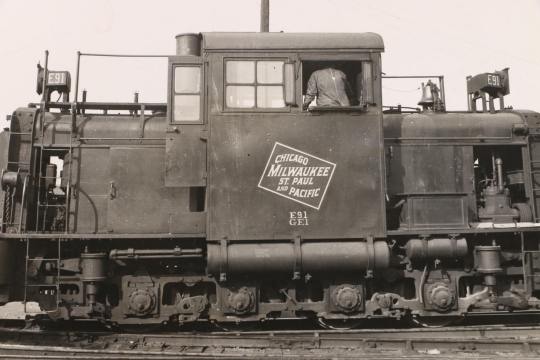
Thousands of photographs of trains.

And behind that first skid he wheeled another skid, loaded with even more.

Marketing felt that these were dump lots, that no one would spend any money on them, based on a few test lots that had been up for sale for a few days. Several other people, my boss included, felt that the product was great but the documentation was poor. Whoever shot the test sales had clearly not known what they were holding, nor did they seem to care, as they took four or five photos of piles of photos and called the whole thing done. For most items we sell, thats not a bad way of doing it. After all, to hit our daily numbers, most lots need to be shot in less than ten minutes, preferably six. You take a master shot illustrating the item, you take three to four angles or closeups showing details, then you document any damage or irregularity. Minimum four photos, usually about eight or nine, try not to shoot more than twelve. And if you’re shooting something that feels too niche or junky or tacky to make money, you spend less time with it so you have more of a buffer when trying to capture the tiny fucking watermarks on stupid crystal glasses. And a good general rule is that the more items are in a lot, the less they’re worth.
But all of these rules fly out the window when you are selling to Train People. You may have known a few. The ones with the model railroads in their basements, exactingly crafted to perfectly represent a particular rail line, or period, or place. The history buffs that out-obsess all other history buffs. No special interest is more granular, or more specific, or more seemingly mercurial to the untrained eye. They’ll fork over good money for a piece of rail history, but no one wants to buy blind boxes of photos sight unseen, hoping that they represent whatever line or time or place they’re looking for. And this treasure trove not only was astoundingly well organized, but almost every single photo was labelled with information, frequently detailing the make and model of the train as well as the time and place the photo was taken.
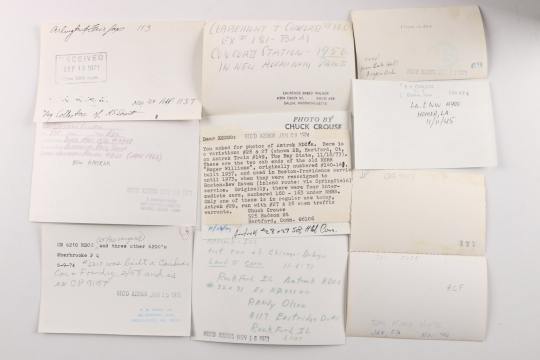
So my boss told me to sift through, document anything that seemed important, spend as much time as I needed and take as many photos as I want. I shot nothing but photos of trains from 1:30 to 7:30pm, taking about 40 minutes per box (each box being sold as a separate lot.)
Get in the next morning at 7:00am, keep going. At around 10, while I’m grabbing the next pile, a woman stops me and introduces herself as one of the Editors. We normally don’t see editors, as they’re four or five rungs up the ladder from photography, and most of their work is digital. They curate the overall estates and sales, revise and correct the research cataloguing does, order photo reshoots when necessary, and generally have the final say on many pieces of what hits the site.
This particular Editor is the one overseeing this sale, and was friends with the man who owned all of this stuff. So I get a little more background: all of these photos were from a Rail-spotting magazine run for 25 years by a local Cincinnati man. Train Fans would send in photos from all over the world to be featured, and this collection was essentially the man’s life’s work. The proceeds from selling all of this (and the piles and piles and piles and piles of other items) go to supporting the hospitalized mother he left behind after his death. So The Editor is deeply invested in making sure that not only is the work well represented, but that it makes top dollar, so that her friend’s work is sold to collectors rather than junk dealers, and that his mom gets a big check to pay for medical care.
Which means that she is profoundly unhappy with the performance of those earlier-mentioned test lots, and livid that attribution fobbed the whole thing off without doing much documentation, and that marketing thinks this all is worthless, and came hunting my boss to make sure that these photos are being shot properly. To say that she seemed skeptical of my care and attention to detail is an understatement.
“Well, I do want you to know that I’m putting a lot of time into these. I’m looking at every photo, pulling all that are in color, pulling any that are photographically impressive with high contrast, and paying particular attention to local lines.”
“You mean the ones marked as being shot here?”
“Well, sure, but also the rail lines that I know pass through Cincinnati. The next box I’m shooting I know is a bunch of B&O so I’m excited for that, since I drive under an old B&O bridge as I leave my neighborhood.”
“B&O?”
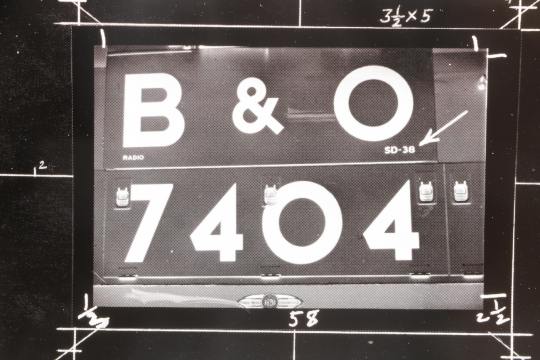
“You know, Baltimore and Ohio. Its the oldest full service rail line in the country.”
“...I guess you are the right one to do these.”
Which is about when the other player enters the scene, one of the two company Founders. She and the Editor had both been on this sale for months, starting at the house packing and organizing this estate, which was so cluttered and filthy and untamed that the Founder called in a personal favor and flew her pal Matt Paxton (one of the Professional Cleaners from the show Hoarders) out to help cut through the muck. So now, months later, in the final hours of a giant project, the presentation of the whole thing is on me. And the decision makers for the whole company are standing around my workspace while my boss shows the work I’d been doing so far.
I was a little stressed.
But as they flipped through, I could see everyone become visibly less tense. My boss explained, “If I had given this to any other photographer in the building, they would have grabbed the first ten photos out of the box, shot just those, then moved on to the next one. I picked Corey because he loves history, and he’s willing to do the work. He’s shooting sixty and seventy photos for each of these lots.”
Which, uh, was a pretty great feeling, not gonna lie. I’m not used to receiving kudos, even just verbally, from bosses, let alone people that high up the food chain.
Of course this was tempered by finding out that this whole sale was going live that night.
This meant that I had about 20 more lots to shoot by 3 in order to give cataloguing enough time to write descriptions and hit complete. It was, at this point, 11:15. The race to finish was not fun, with my boss jumping on the sweep next to mine for the last two hours, as we steamed across the finish line around 4:30. At that point, I was kaput. Completely finished. I spent the last three hours at work sleepwalking, came home, and melted into my chair. I told Jo it was an incredibly stressful day.
And it was.
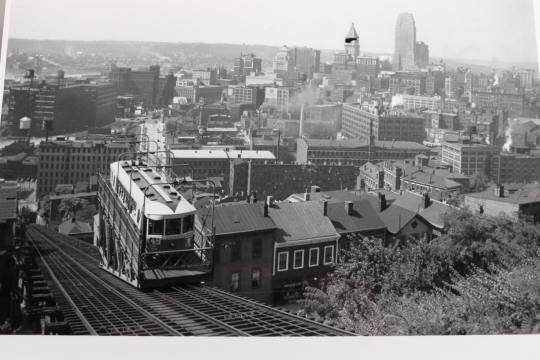
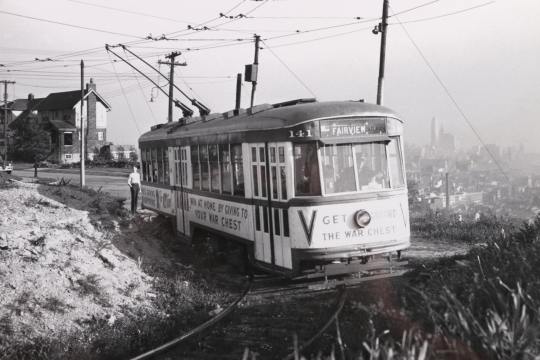
(Hey look, its Cincinnati! Back when the Inclines were running.)
But I keep thinking about that feeling. Because this isn’t the same stress I’m used to. And I know this seems so obvious or blase, but every job I’ve had has been stressful. I mean, every job is stressful in its own way. But I’m not used to that stress being...rewarding? In the same way that art or film or woodworking, creation for my own purposes, is stressful.
I know I’m saying “the sky is blue” as if it were a new discovery I’d made, but I’m so unused to feeling job pressure that resolves not as misery but as accomplishment. Three years at Lowe’s and every day was “oh no, I have to do this again tomorrow? How!?” and finding victory in the tiny little footholds of humanity that I got from one customer out of a hundred. I emotionally have no idea how to process “my boss and my boss’s boss and their boss are all impressed with my random assortment of knowledge and ability to organize information.”
This is not a complaint, mind you. Not even a little bit. Just a very gratified confusion.
Anyway, if you’ve read this far, thanks. As reward, have a photo taken sometime in the 70′s about a block away from my house.

33 notes
·
View notes
Text
Jaye Jayle interivew // Destroy//Exist
No Trail and Other Unholy Paths, the upcoming album by Jaye Jayle, follows the band's mighty impressive recent offerings, House Cricks and Other Excuses to Get Out, their debut full length from 2016, and The Time Between Us, a collaborative EP with Emma Ruth Rundle. There are a few points about it one could emphasize on right off the bat, like the fact that it was produced by David Lynch’s music supervisor of the last twelve years, Dean Hurley, that it features another collaboration with Rundle, and that it bears no specific beginning or ending, with its songs designed to be experienced in any sequence the listener chooses.
Full interview via Destroy//Exist.
Jaye Jayle's Americana-noir sound has always been enticing, but never voiced better than how it is on the coming record.
The multi-talented and cultivated Evan Patterson answers a few questions.
What made you decide to put Young Windows aside and begin a project like Jaye Jayle with such a different sound and approach?
Young Widows hasn't been put aside. I hold the songs and experiences very dear. Nick and Jeremy started families. The time available to create, write, and travel became infrequent. For many years prior to conceiving Jaye Jayle I had been wanting to make compositions that were based around stories or vocal melodies as the lead instrument. Lending the music to relax and settle down somewhere similar to that of film score. I've touched a bit on that concept and sound with Young Widows.
Never thought of my music groups as being projects. Maybe when Jaye Jayle was first conceived it was more of a project. The process of creating as a group is such an emotional and personal investment. Each piece or song is more of the project within the group.
How would you describe the band's present dynamic? And how has it advanced since the previous album?
The group has a steady dynamic. Neal, Todd, Corey, and I spent the majority of our lives together in 2016 and 2017 touring. The closer we become the more advanced our communication through music becomes. Experimenting is much easier now, allowing the songs to be elaborated. House Cricks was a collection of songs from four different sessions. No Trail is consistent to a sound and mood composed as the group.
What does Dean Hurley bring to the album's sound design? and how does his production complement the compositions?
I believe that what Dean enjoys to hear in music is what I also enjoy to hear in music. We sent him a massive amount of tracks; Low Again Street had near 80 tracks to sift through. Dean had total creative control as the mixing producer. The result is a wide colorful spectrum of sounds. It's exciting to be able to work with him.
There's great chemistry between Emma Ruth Rundle and yourself, evident on your prior collaborative EP and on Marry Us, a captivating song on the new album. Are there any other artists you'd imagine as ideal collaborators for Jaye Jayle?
I'd loved to collaborate with more artists. Yes, more collaborations are must. It's preferred. I dreamt of asking Rachel Grimes if she'd like to collaborate on a piece or album, but have been delaying asking. Drew Miller's saxophone on the album is another perfect example of leaving sections of the composition open for additional collaborative improvised instrumentation. Honestly, I feel that even working with Dean is a collaboration.
I had the pleasure of collaborating with Emma on her new album earlier this year. No hand in writing the songs, but total freedom to write the additional second guitar parts. Her album came out gorgeous. I'd also love to join more artists.
Do you prefer physical media over digital? Are you a record collector?
I prefer all formats and sources for anyone and everyone to listen to music. I just made a playlist on Spotify and was shocked by what all is available through that outlet. I am a record collector. I bought a record today by Flash and the Pan. Their song Walking in the Rain is perfect. The record was three dollars. I'm collecting Ennio Morricone scores.
What are you currently listening to mostly?
I've been listening to the score for the film Marco Polo by Ennio Morricone in the evenings. The album Time Was by Zomes has been a favorite for the past three years. Fela Kuti in the mornings. The two most recent PJ Harvey albums are regular listens while on the road. Tangerine Dream, Jim Reeves, Fred Neil, and Einstürzende Neubauten.
Outside music, what other sources have had heavy impact on your creativity?
A few. Looking above the rolling hills of Kentucky or the desert in New Mexico. Any elevated perspective or a landscape is inspiring. To see nature in all its beauty gives me a sense of clarity. Film is an big inspiration. Phantom Thread was great. I've also been doing my best to see more visual art around Louisville. There's a few museums in town that are curating some fantastic exhibits.
The new album's cover looks wonderful, rather abstract at first glance and ultimately pretty bleak. What made you choose that image to represent the music?
There is something relieving and yet tortured with the image. Placed between the lightness and darkness of nature. It's a balance between those two worlds. Stuck between the heavens and the hells of mental health.
Having the songs on the record arranged to be non-linear and interchangeable is a very interesting approach, and not something we encounter often. What made you decide to design the LP that way?
The concept came to me from feeling that regardless of my options and my choices in life, regardless of door A or door B, my paths would have me ending up ultimately in the same placement. We hope to do the things we love and survive. The idea of my desires have seemingly taken me to a place that I felt I could have been in regardless of which wall I tore down or which forest I cut through or ocean I swam through. Forward motion. The direction is not what's important. I've just kept going and trying to bring a sense of joy out through art and never give in. I'm not making this music for anyone else. I'm making it because it makes me feel alive. I have survived thus far because I've continued to not just fall into a pattern or follow a format in life. Everything I live for still feels very strange and exciting. Life is a constant surprise. Guaranteed.
What does the near future hold for Jaye Jayle?
The album is out in nine days. We're announcing nine weeks of touring soon. If all goes well, I'd love to complete another album by the end of the year.
No Trail and Other Unholy Paths releases June 29th, 2018 via Sargent House.
1 note
·
View note
Text
Condensed Marvel Movies
I’ve talked to a few people who were planning on watching infinity war without having seen a bunch of the other marvel movies, and they said they had nerdy friends pushing them to watch every single marvel movie that came out before Infinity War, which is frankly ridiculous. I made this kind of helpful guide to help out said people.
Iron Man * A man named Tony Stark owns Stark Industries, he’s very rich and very smart * Has a friend named Colonel Rhodes and an assistant named Pepper * There is a government agency called S.H.I.E.L.D. * Tony Stark built a robot suit to escape from terrorists and became iron man and has some energy thingy in the middle of his chest bc there is shrapnel in there
Iron Man 2 * Tony Stark is officially Iron Man but oh no his chest thing is killing him * He briefly gets a new assistant but she's actually an assassin who works for shield * He makes more suits gets a new chest thing gives one of his suits to his friend Colonel Rhodes and gets together with his assistant yay everyone is happy
Thor * Norse gods * Thor is the god of thunder and he has a kick ass hammer * His brother is Loki * There is a lot of tension there Loki does some messed up shit and basically Thor ends up on earth for a bit but then he goes back * S.H.I.E.L.D. shows up just long enough to meet Thor and then peace out * Oh also shield has another assassin but this one is male and has a bow
Captain America: The First Avenger * Boring, vanilla, skinny white dude named Steve wants to join the army in WW2 * He can’t so instead he gets injected with a super serum that makes him very fit * Also apparently he doesn’t age anymore hooray * A Nazi scientist tries to steal a very powerful cube called the tesseract and hitler almost wins but instead the scientist dies and the cube goes somewhere in the ocean * Captain America drowns and wakes up 80 years later and meets S.H.I.E.L.D. (specifically there is a man with an eye patch his name is Nick Fury he’s only there for like 2 seconds tho) * This one is long bc it’s sole purpose was to set up for the avengers movie * Also Captain America had a best friend named Bucky but he fell off a train * Also also Tony stark’s grandfather actually found the super powerful cube its not in the water anymore
Marvel’s The Avengers * There are two assassin-type people named Black Widow and Hawk Eye we have literally never met them b4 but apparently they work for SHIELD ok sure * Loki tries to steal the very powerful cube in order to become Earth’s ruler so SHIELD gets Iron Man, Captain America, and the Hulk (or Dr. Banner) to help them defeat him, then Thor falls out of the sky and joins the crew * Agent Coulson, the og SHIELD guy, dies at some point whoops #neverforget * Turns out Loki teamed up with some aliens, they attack New York with giant centipedes but Iron Man throws a nuke at them and they win * Thor takes the powerful cube to the Norse gods’ floating castle * Also it turns out that the aliens’ master had another master oohoohoo what a reveal didn’t see that one coming
Iron Man 3 * Iron Man can control his suit with his watch now * I think his girlfriend can shoot fire out of her arms??? * He gets surgery so he doesn’t need the chest thing but I don’t think that matters anyway * He destroys a lot of his Iron Man suits but I don’t think that matters either
Thor: The Dark World * Thor’s girlfriend discovers a new super powerful stone, but this one is red * A bunch of elves try to steal it so Thor has to take Loki out of prison so they can fight the elves together * They win but Loki dies but actually not really he pretends to be their father and Thor leaves so Loki gets to fake being king yay * Also there is a guy collecting stones he takes the red one but the blue cube (yes its part of the stones) is still with the Norse gods but actually there are 5 stones * There’s an ice monster in London not sure why he’s important though
Captain America: Winter Soldier * Captain America is a vanilla goody-two-shoes obviously he’s the only guy who hung around with the government agency * While out running he makes a new friend and when they’re on the run from said government agency later on he gets metal wings * Oh hey look his best friend Bucky is back! Not dead, just an immortal Russian spy with amnesia and no arm * SHIELD was infiltrated by Nazis whoops how did that happen its ok though Captain America saved everyone not before almost dying though * Russian Spy Bucky pulls him out of the water after almost killing him and Steve takes that as a sign that he wants to be friends again so he goes looking for him * There are two x-men mutants in a lab somewhere idk
Guardians of the Galaxy * Ok this one is really complicated and annoying and has way too many main characters but whatever * So a smol goofy human child named Peter is stolen by aliens and taken to space and some shit goes down I honestly can’t remember * He finds a glowing orb which turns out to be ANOTHER super powerful stone yay but not before its stolen by an evil person working for a big purple guy who was actually in charge of attacking New York with aliens that one time * He teams up with a raccoon, a tree, a blue alien, and a sexy green alien (she and peter get together later I think) who happens to be the adoptive daughter of the purple guy and they try to defeat the evil guy and succeed * The tree dies and creates a baby tree who’s honestly so much better also the smol goofy human child is actually only half human * The super powerful stone hangs out on some rando planet but its a super powerful stone so u know its coming back
Avengers: Age of Ultron * The Avengers crew is back together! They’re rounding up all the left over Nazis who are still just kinda there and they eventually find the x-men twins but they’re x-men twins so obviously they run away * Turns out the left-over nazis also had a super powerful stone and Iron Man uses it to build an A.I. which surprise surprise turns out to be evil and tries to kill all the humans buy dropping a city from the sky but that’s really not important * In Korea someone is building a fake body around the super powerful stone for the evil robot but the Avengers steal it and put Iron Man’s digital assistant in there instead * They defeat the evil robot and now they have a British red man floating around in a cape which is pretty cool also the male mutant twin dies * The larger-than-average purple man is getting annoyed by his inability to find the super powerful stones and puts on a big glove
Ant-Man * Literally nothing useful is revealed in this film except for like 3 things * Over the past four years, Paul Rudd has somehow managed to age -2 * There is now a hero with the frankly useless ability to become very, very small * Captain America found his best friend!
Captain America: Civil War * For a movie centered around one guy, this has way too many characters. Also, this is the official time to start shipping stucky (Steve and Bucky a.k.a. immortal boyfriends) * So basically the Avengers (who are now a mix of some og members and other less interesting new members) accidentally destroy a building that kills a few ppl and the UN is not pleased * They propose that the government should have more control over the crew and Tony (Iron Man) agrees bc he’s still feeling guilty about his killer robot but Steve doesn’t like that idea and the Avengers (old and new) split into democrats and libertarians * The democrats (led by Tony Stark) get a couple new members and now the teams are as follows: democrats - iron man, spider man, ant man, a panther super hero, iron man’s bff, the red British AI guy, and black widow (aka one of the assassins who’s been hanging around for a while) vs the libertarians - Steve, his boyfriend Bucky, his new friend with wings, the living mutant twin, ant man (why), and the other assassin who’s been hanging around for a while * Basically shit goes down and Steve and Tony are no longer friends, then Bucky runs away to hang out with the panther hero, and spider man is kinda part of the crew yay * Also Steve loses this really cool shield that’s stuck with him for a while now which isn’t important but it’s a bit sad #neverforget
Doctor Strange * Benedict Cumberbatch is an American (ew) doctor with an extremely stupid last name who injures his hands in a car accident so he can’t operate anymore * In search of a cure he finds some pretty dank wizard monks who teach him their wizard monk ways and give him a sentient cape and another super powerful stone except this is literally the only important one because it controls time * Doctor Strange (seriously wtf) defeats some evil person—but honestly who even gives a shit anymore—and then he meets up with for some reason Thor and Loki
Guardians of the Galaxy Vol. 2 * This movie is honestly completely unrelated to anything so I’ll be brief * Sexy green alien aka Gamora has an estranged droid sister with whom she reconciles but her sister leaves again to try and kill their purple dad * Peter finds his real father but it turns out he’s evil and he fucked a lot of animals which is pretty gross but it’s ok because peter kills him in the end * They find this bug-like alien who also looks kinda like a female human and she starts tagging along with their crew and they go off to kill the purple guy
Spider-Man: Homecoming * This is another relatively useless movie but we do learn a few interesting things * Spider-man is a goofy, relatable high school kid with a questionable taste in women and a really beautiful father-son relationship with Tony Stark * He’s also low key not part of the crew but he really really wants to be * Unrelated but Zendaya plays a really hot nerd girl who I refuse to believe isn’t gay to some degree
Thor: Ragnorok * Thor gets fucking hot ngl also his relationship with Loki is sibling goals * So it turns out Thor has a super evil sister and she comes back in order to kill a lot of people, so Thor and Loki end up on some planet where people have to fight each other for the entertainment of the rich people gladiator style, except Loki obviously befriends the rich people and Thor has to stay a gladiator. Also for some reason the hulk is there * They meet a super hot lady goddess and all of them go to the floating Norse god castle and kill the evil sister and get on a ship but then they run into a big most likely evil ship oh no
Black Panther * Really this is the only one that you should actually watch like every single character is both awesome and attractive I would date all of them but u know Shuri is my soulmate * Seriously just watch the movie I’m not summarizing this one
#iron man spoilers#iron man 2 spoilers#thor spoilers#captain america spoilers#avengers spoilers#iron man 3 spoilers#the dark world spoilers#winter soldier spoilers#guardians of the galaxy spoilers#everything spoilers#I'm sick of tagging them#just read the first paragraph then make an informed decision#this is pretty useless ngl#but I had fun making it#if ur a marvel nerd pls don't hurt me
1 note
·
View note